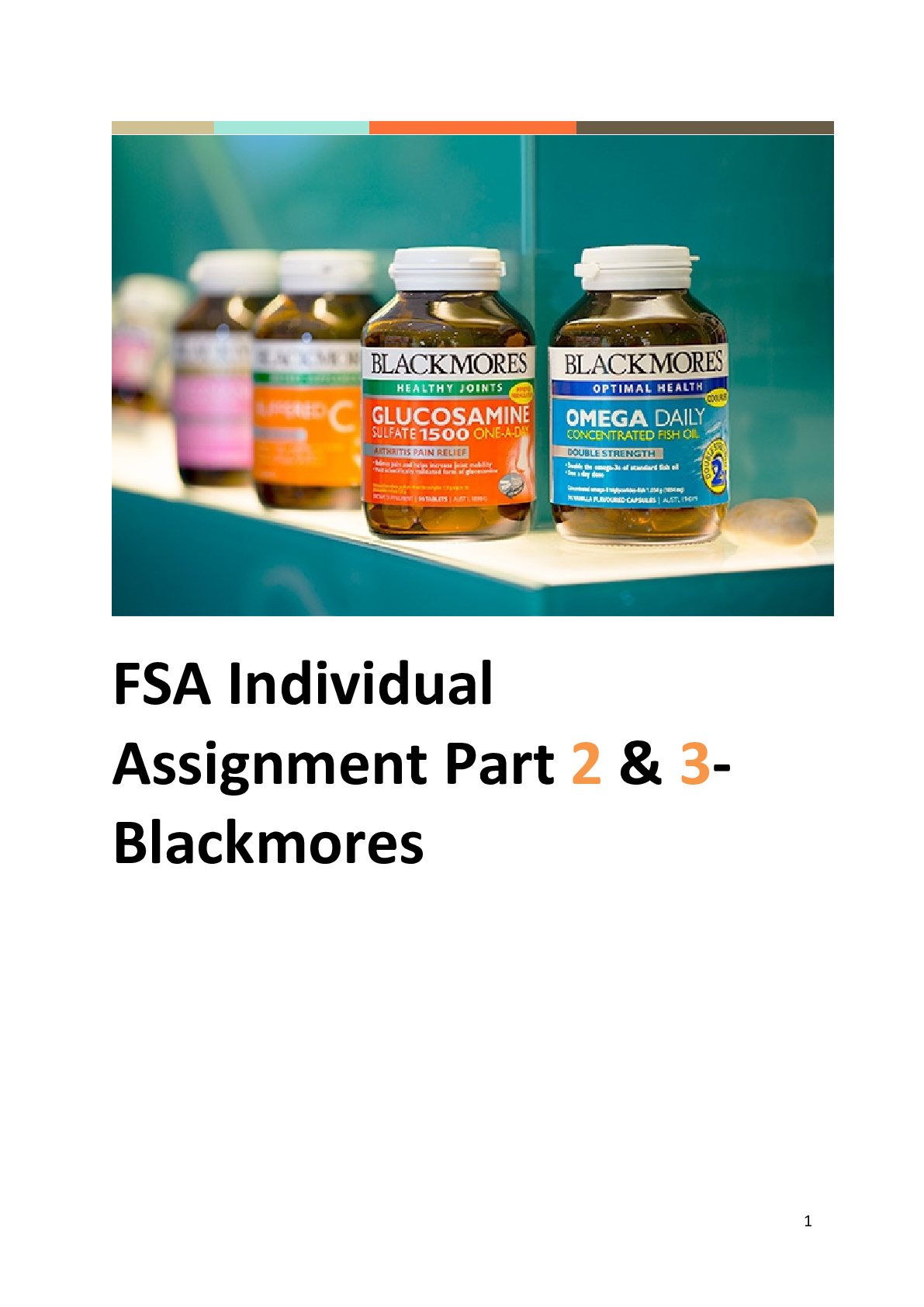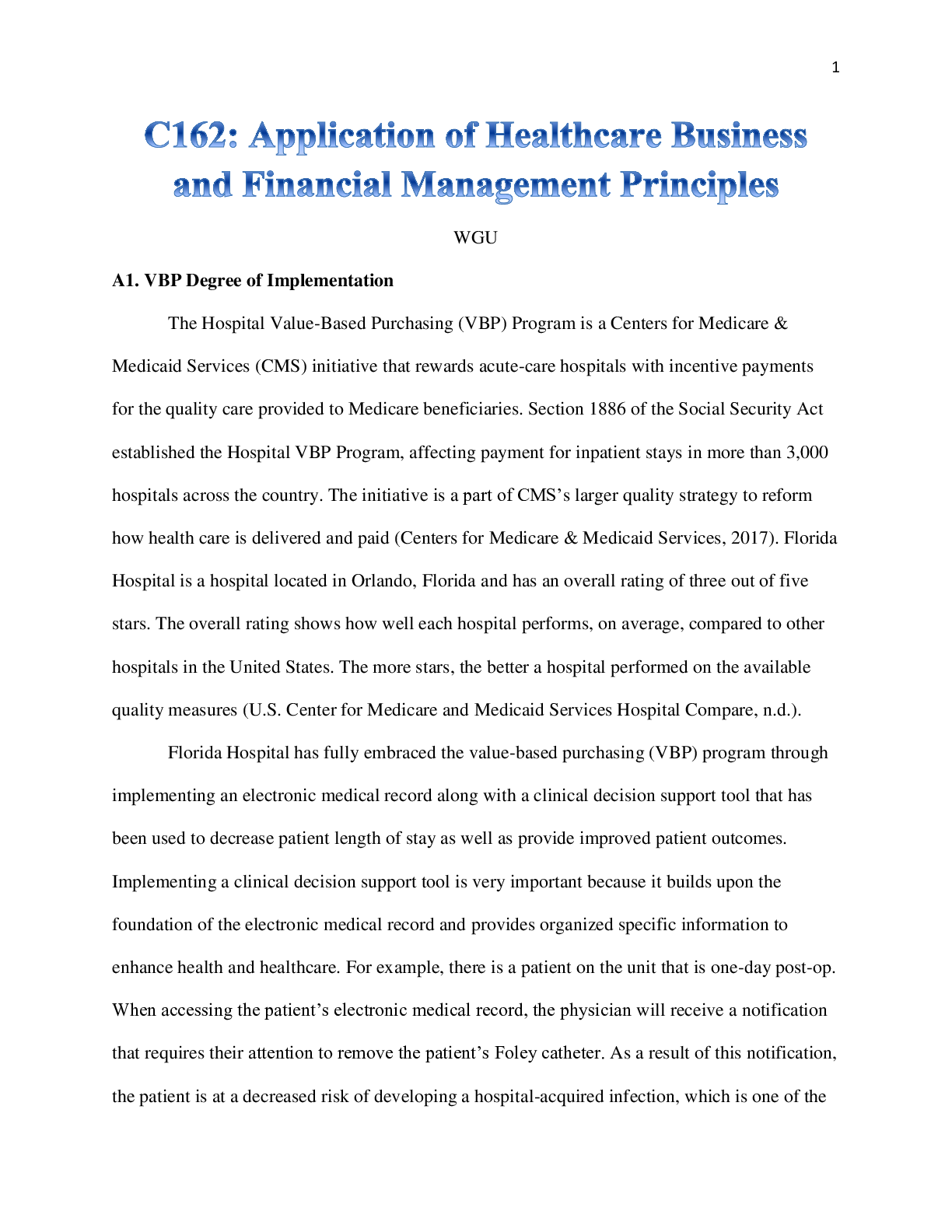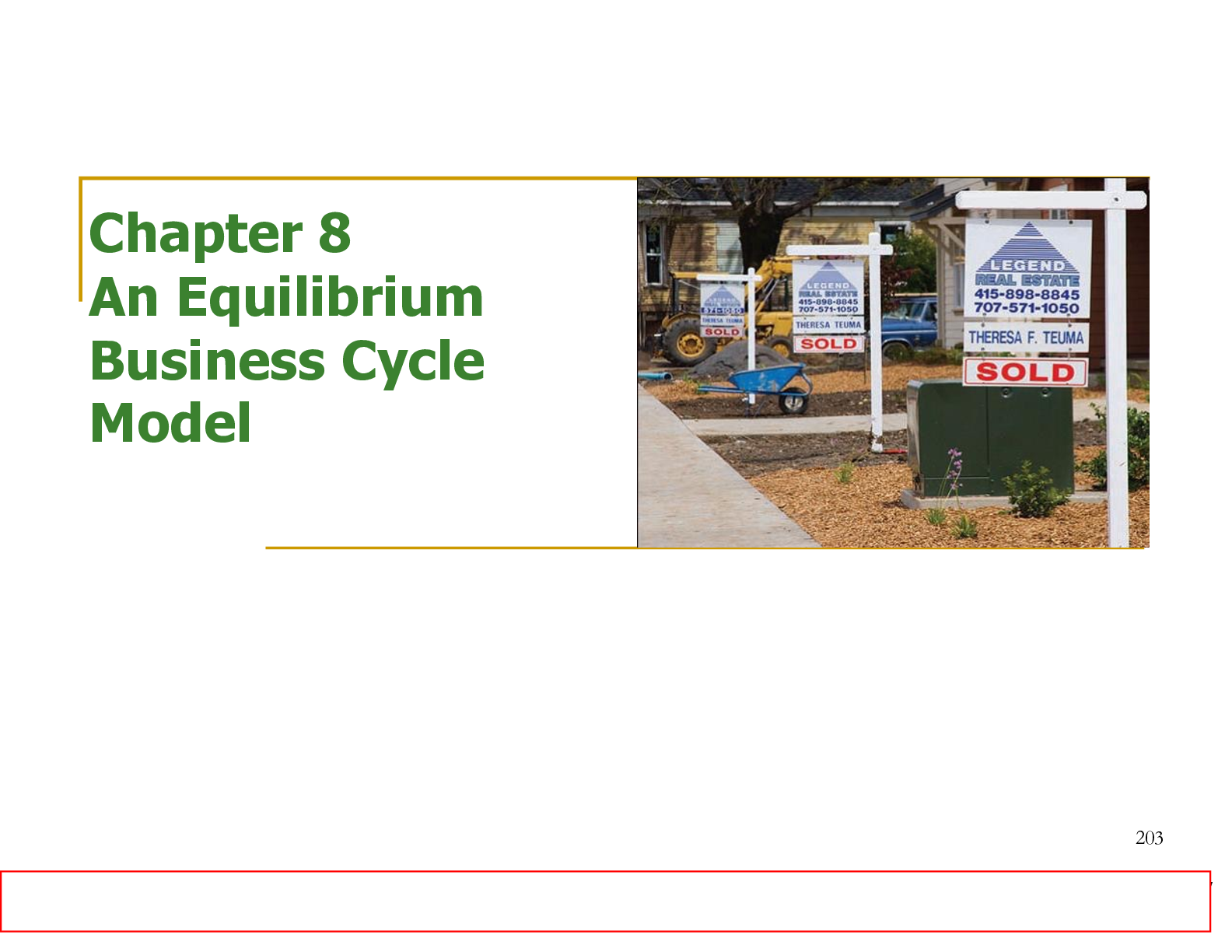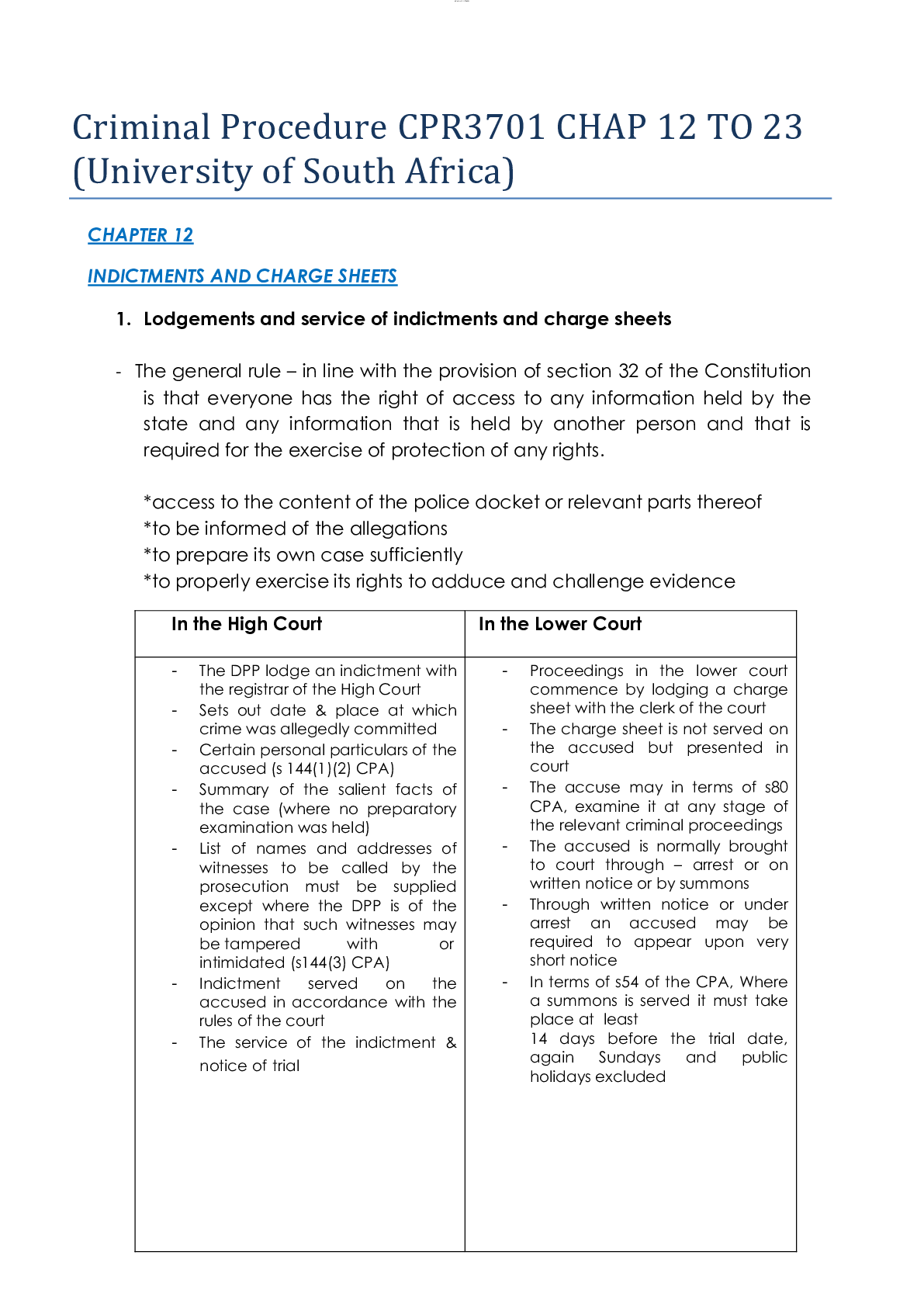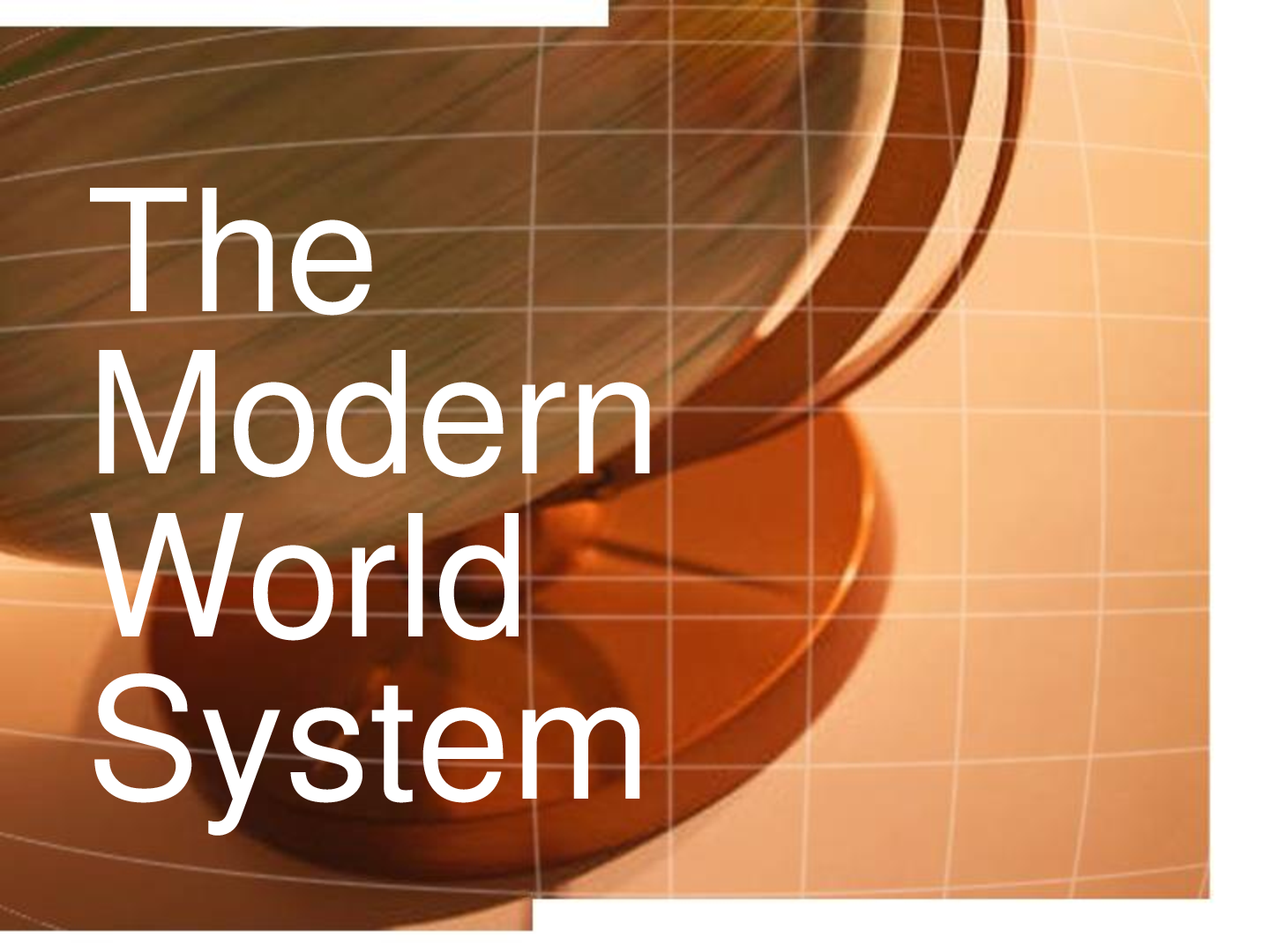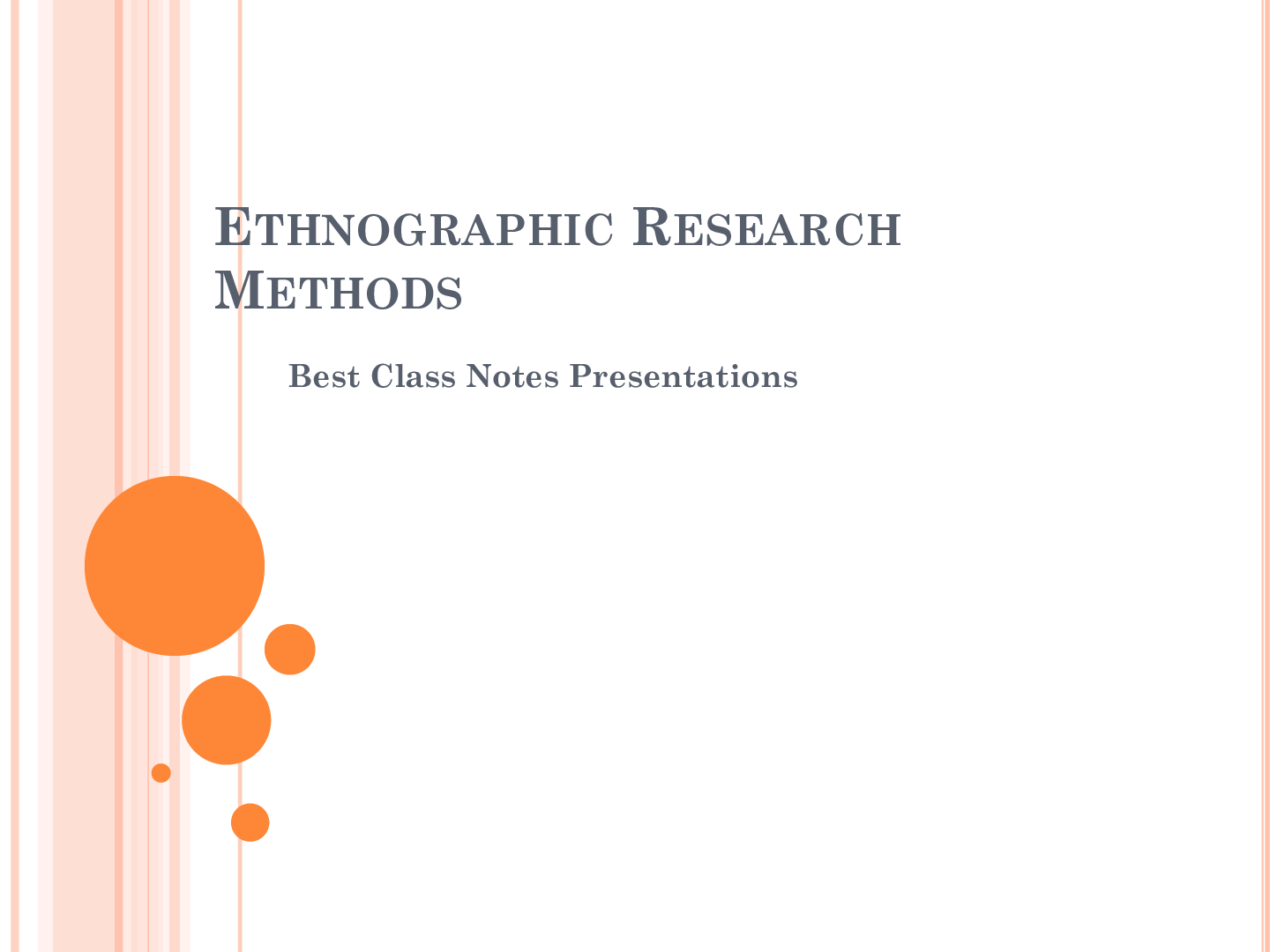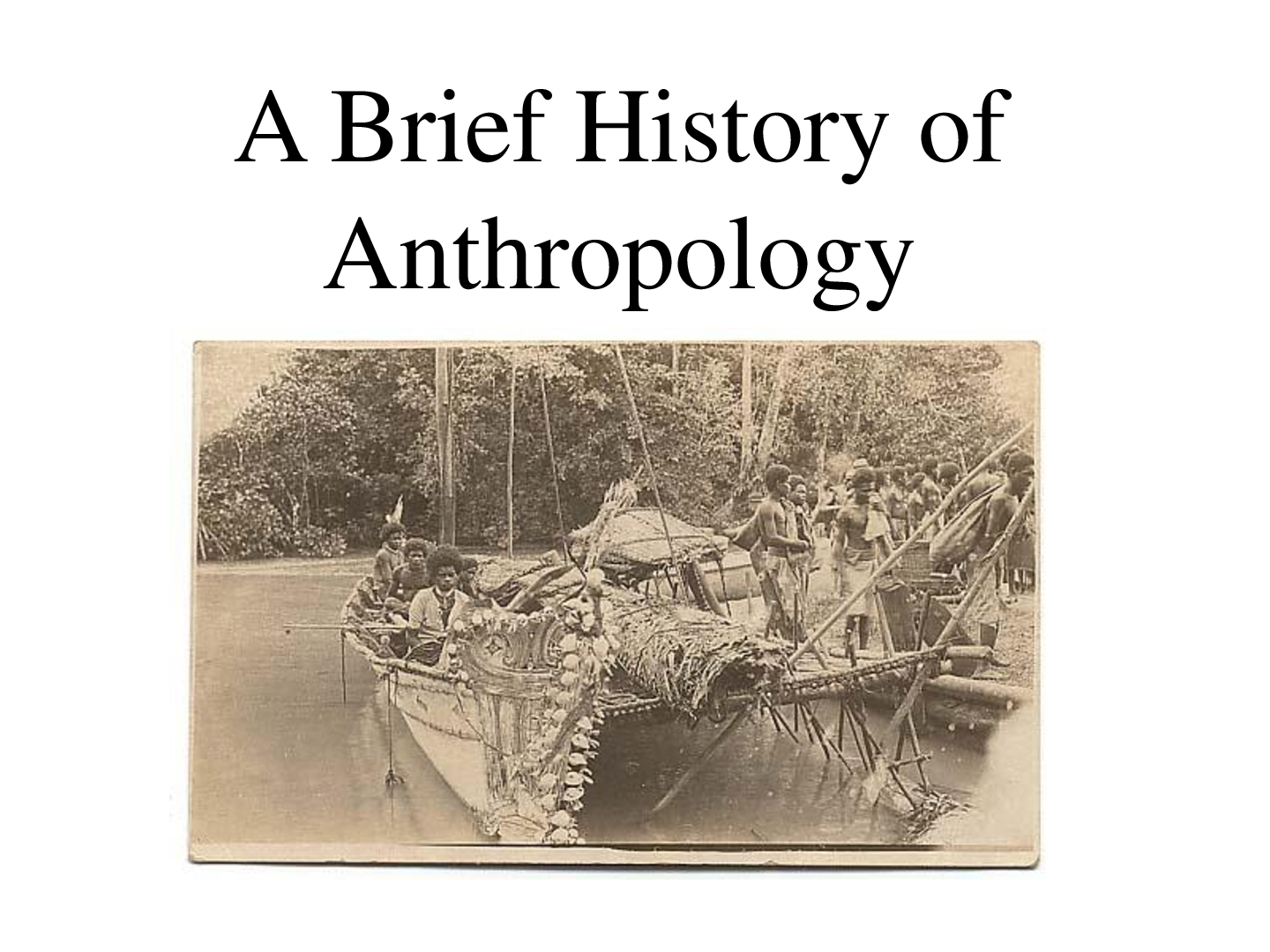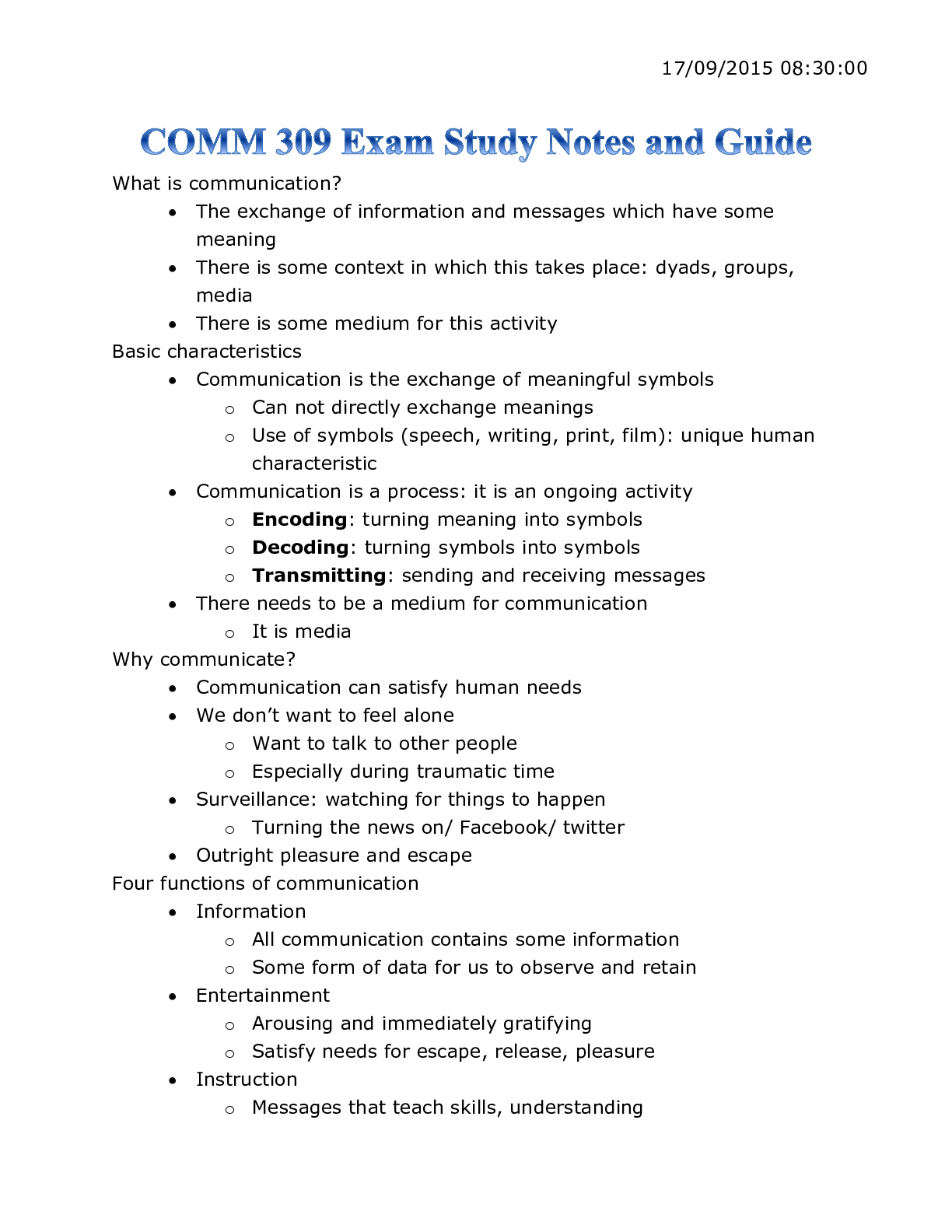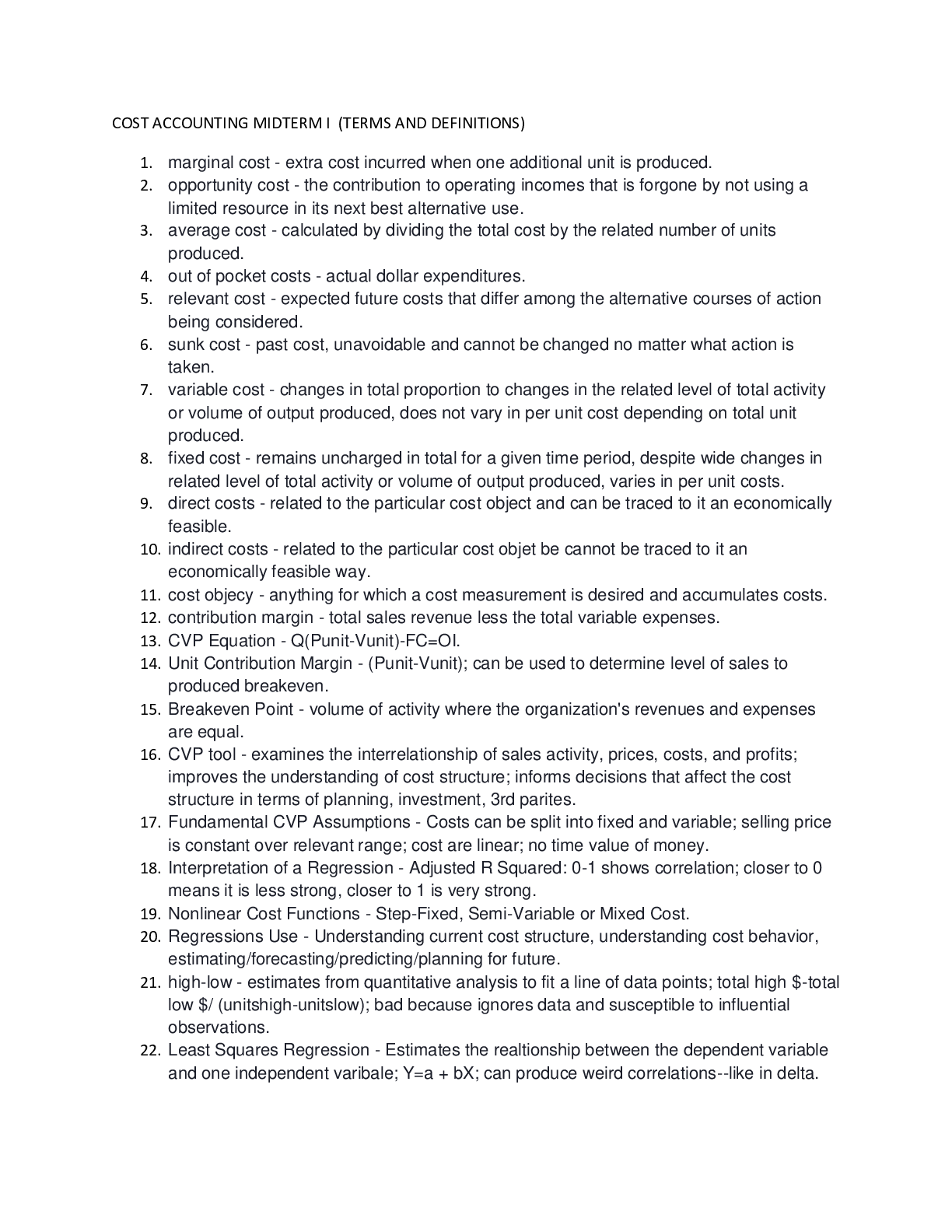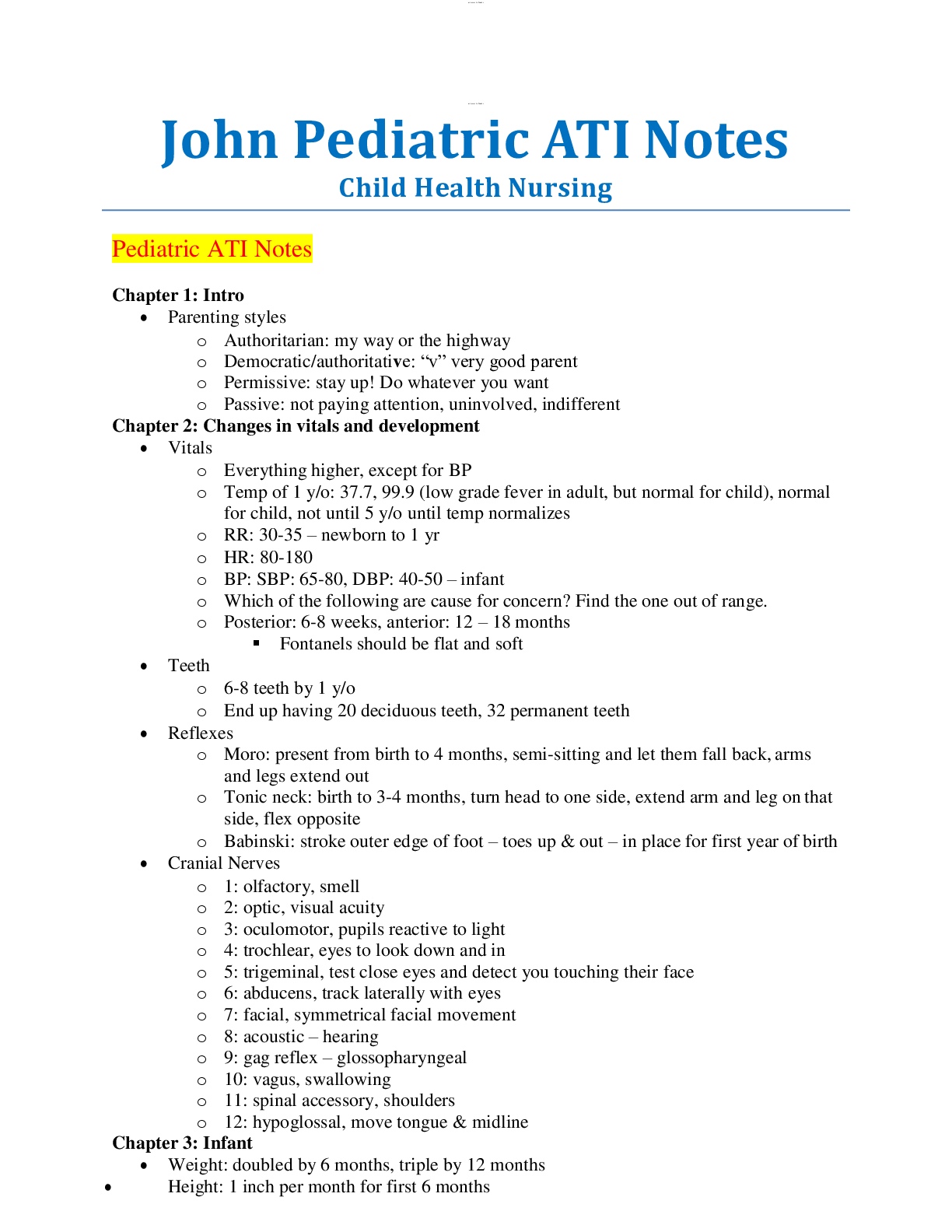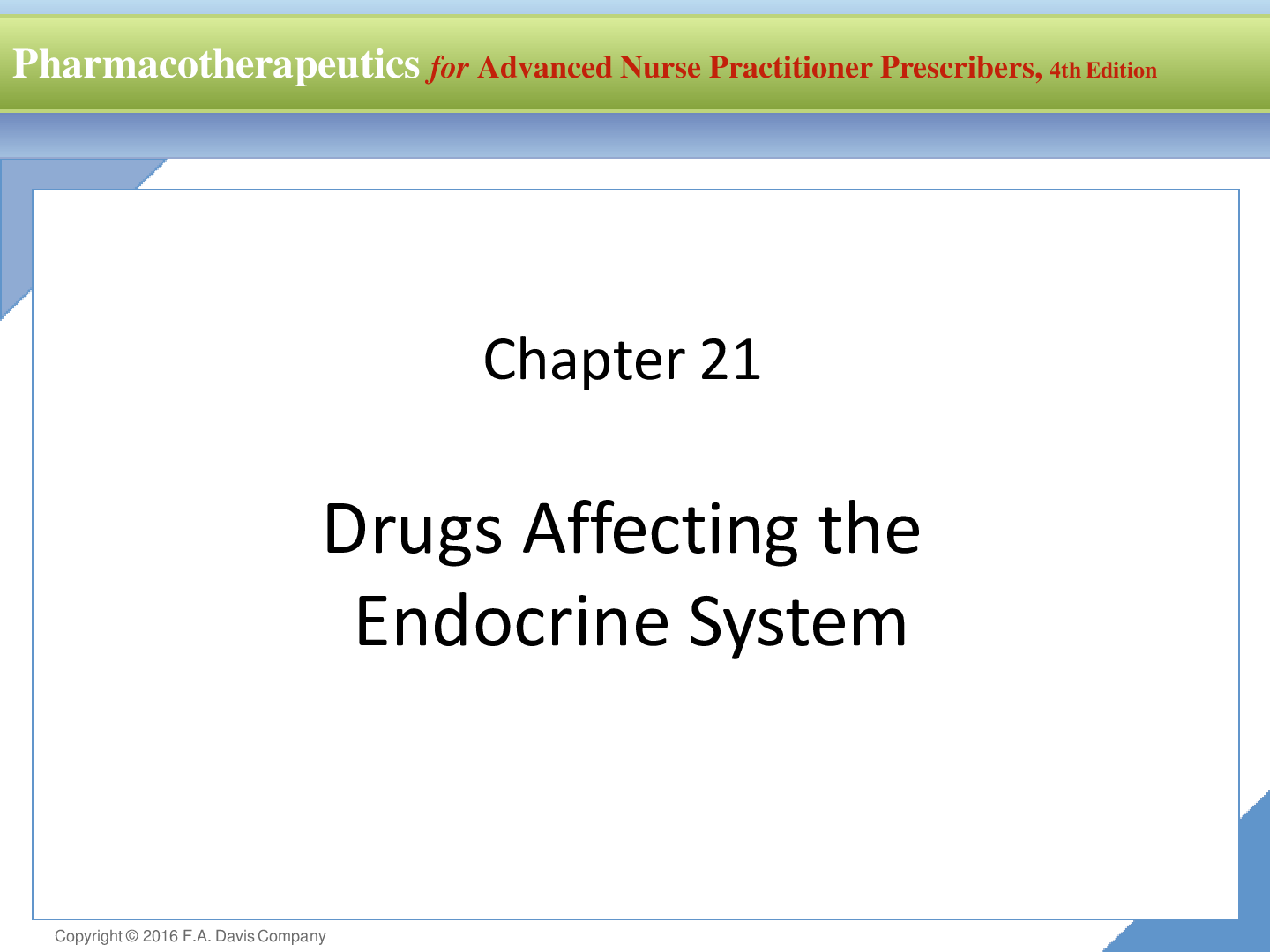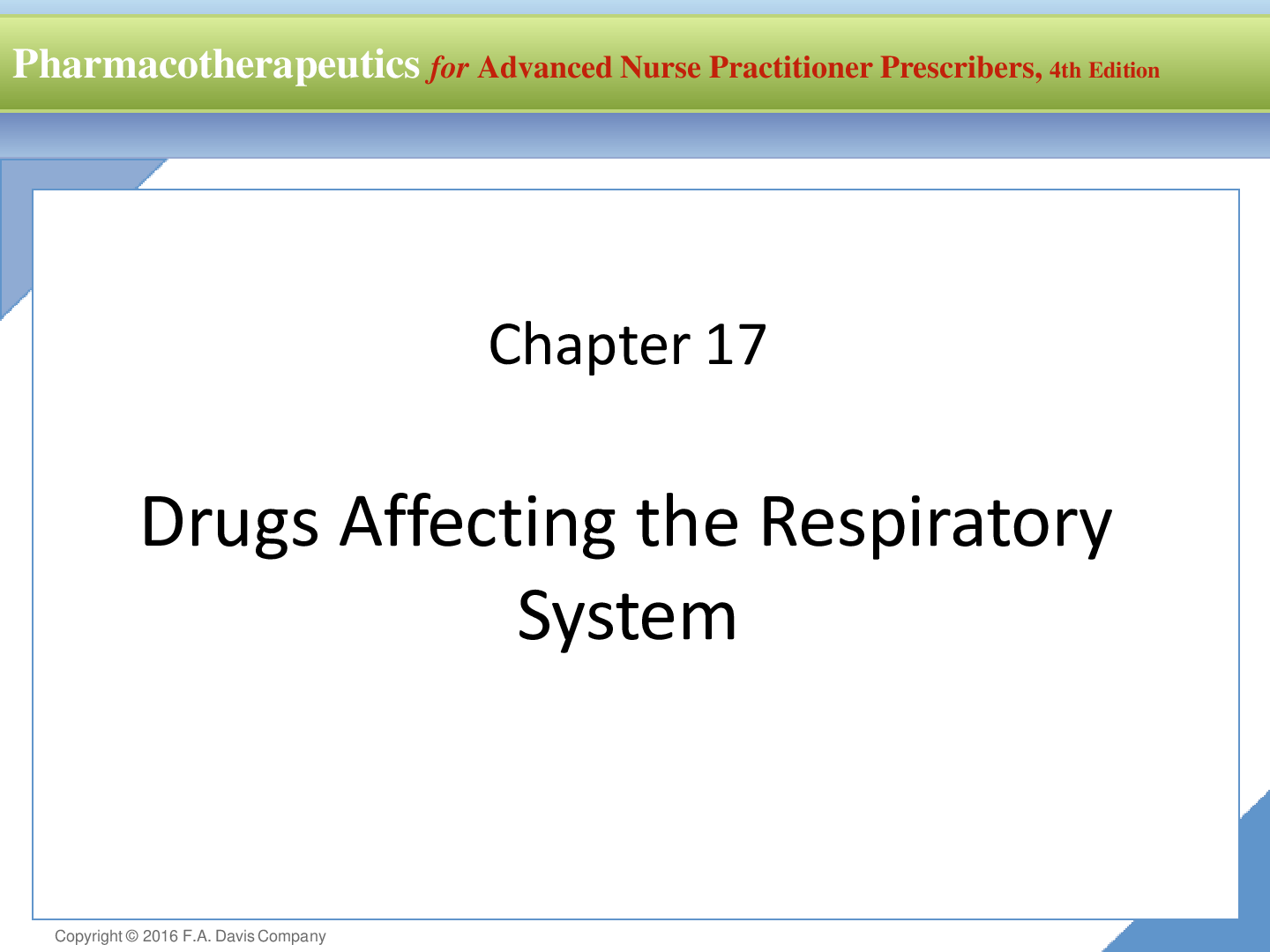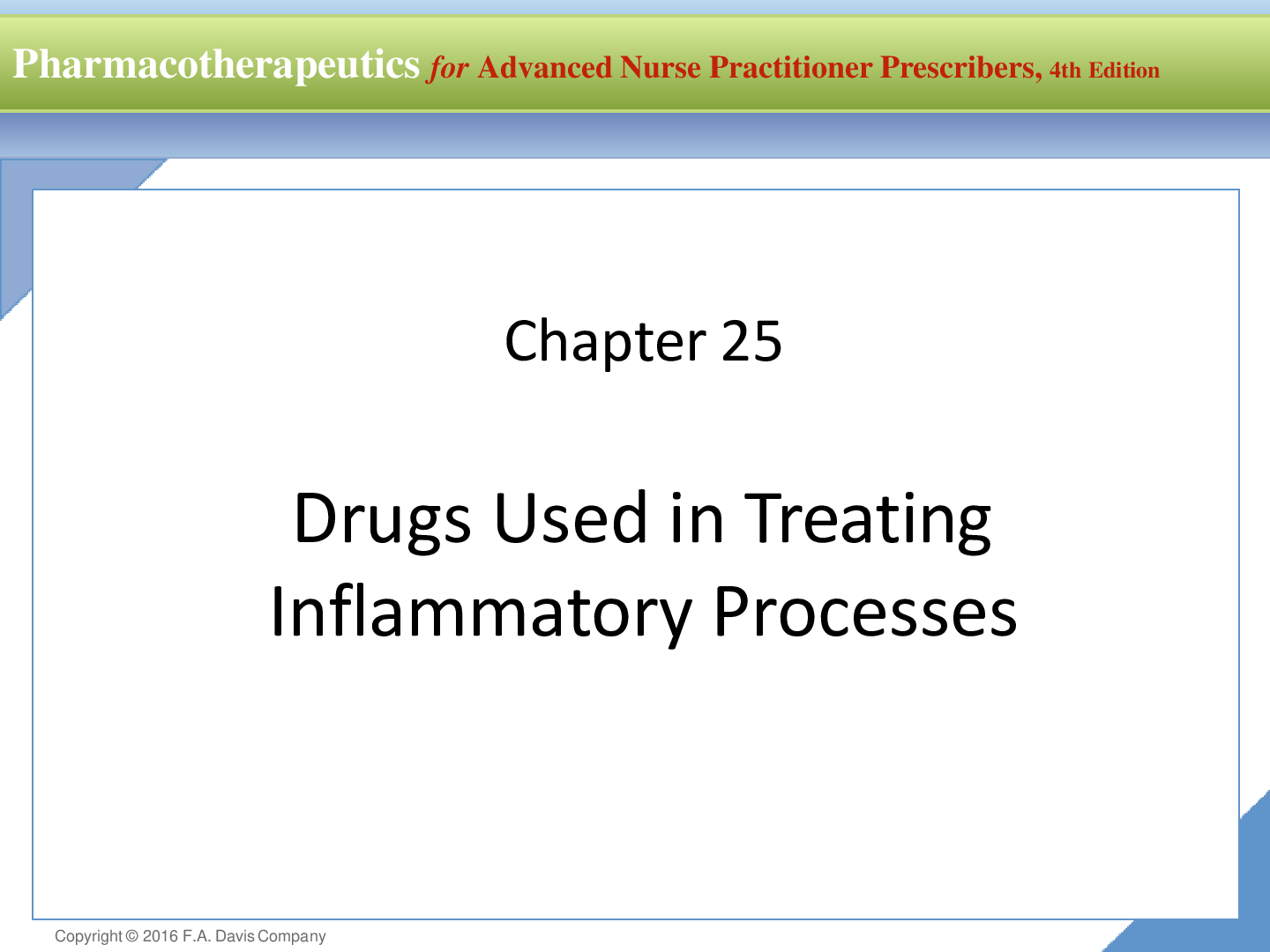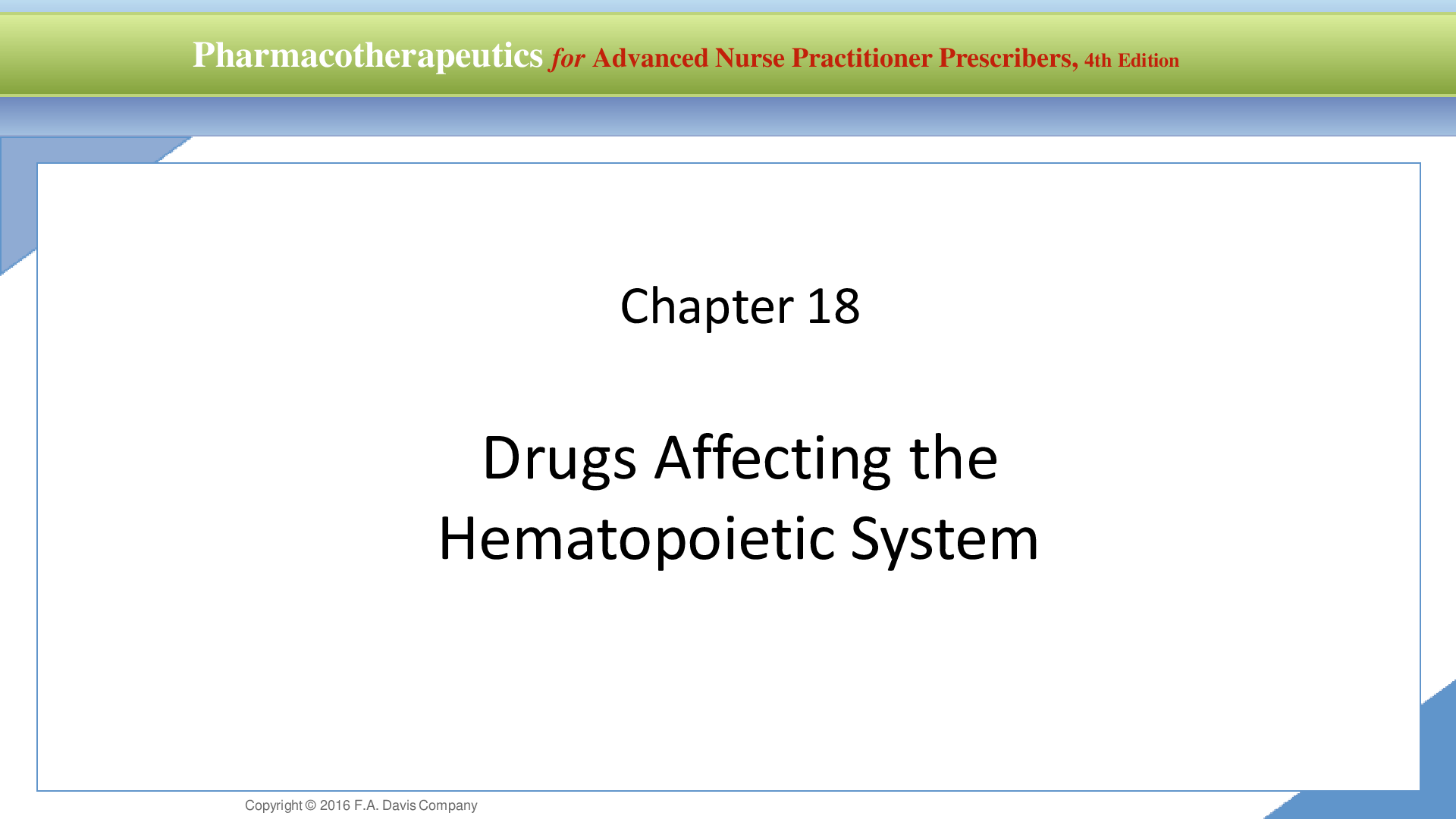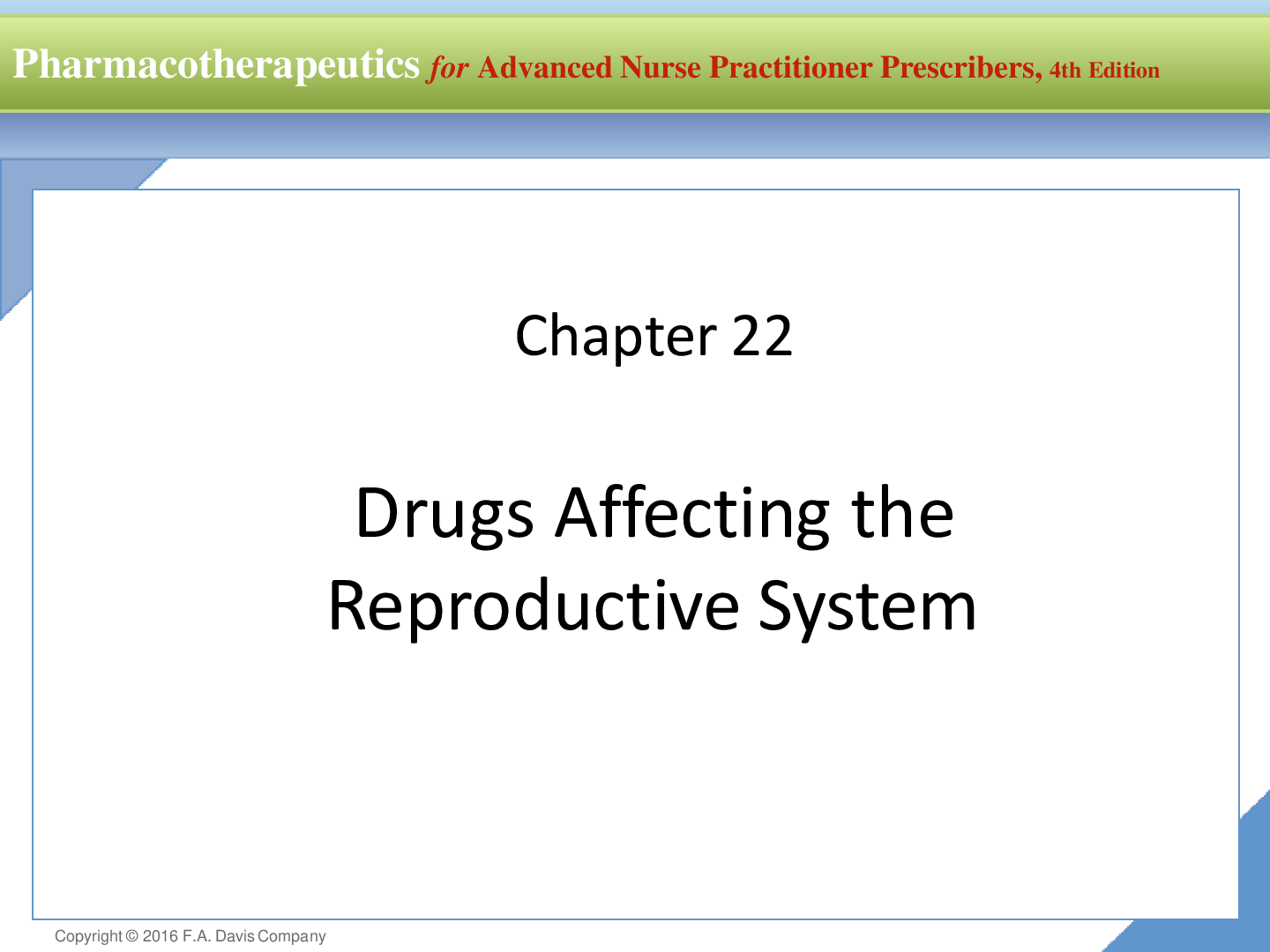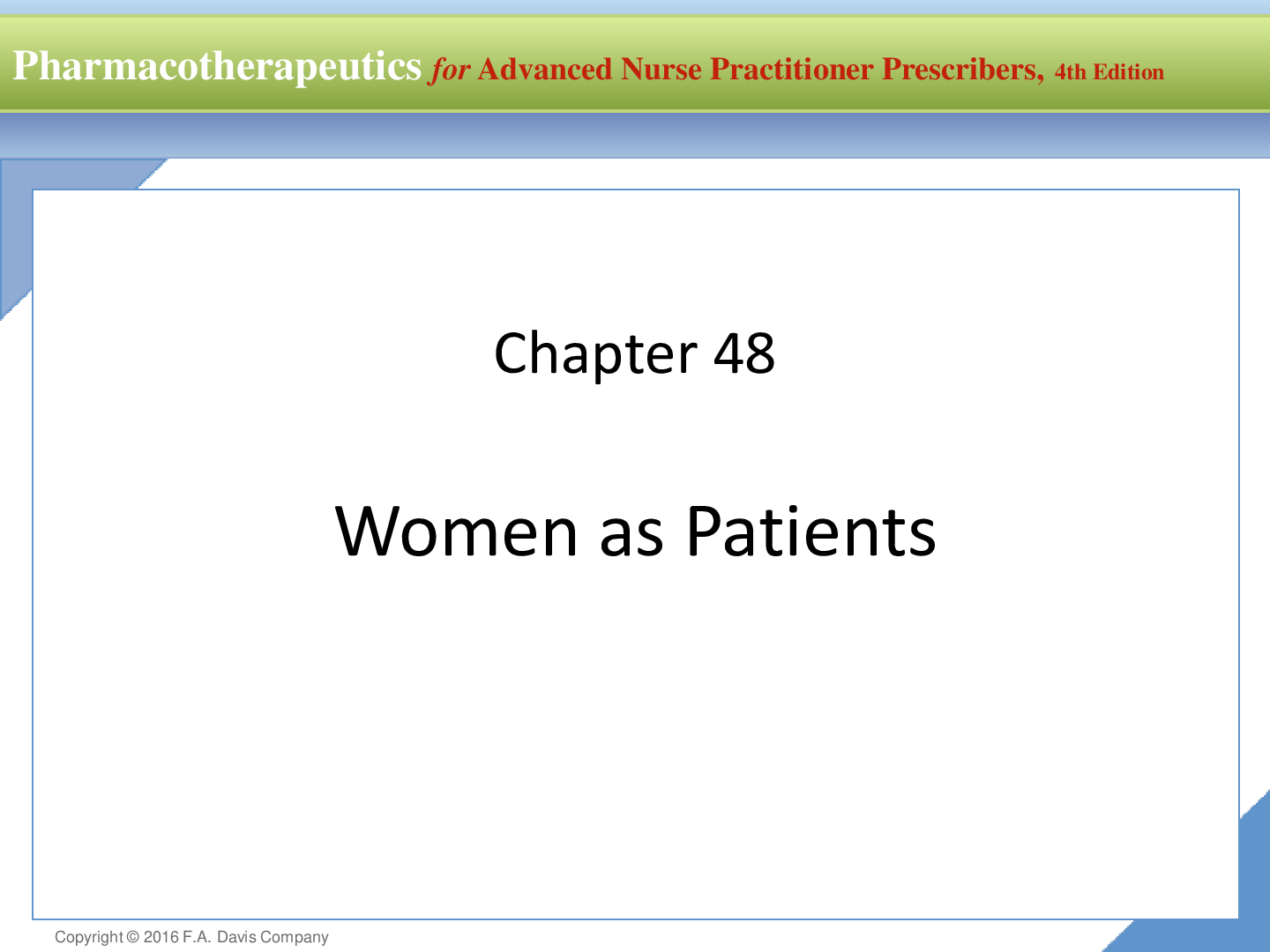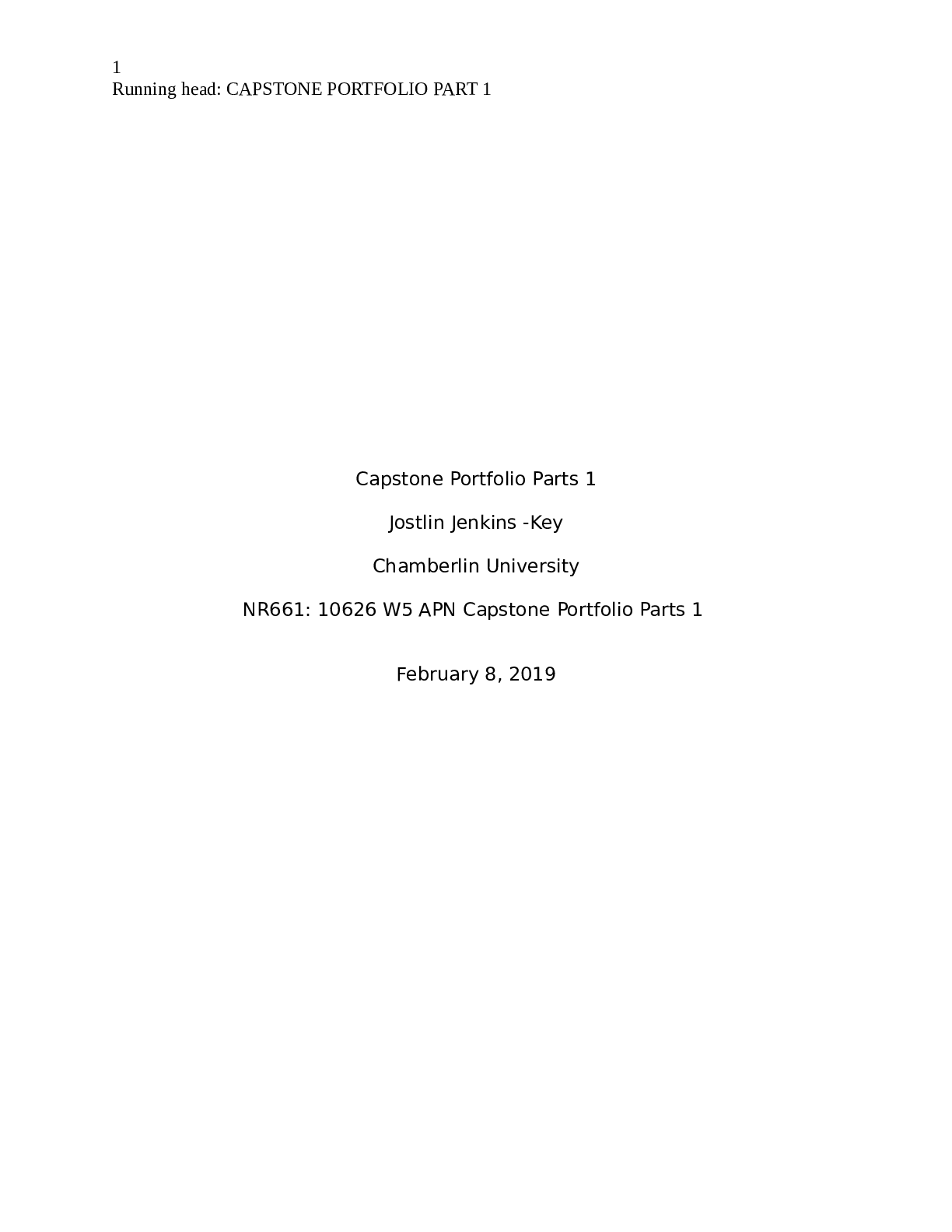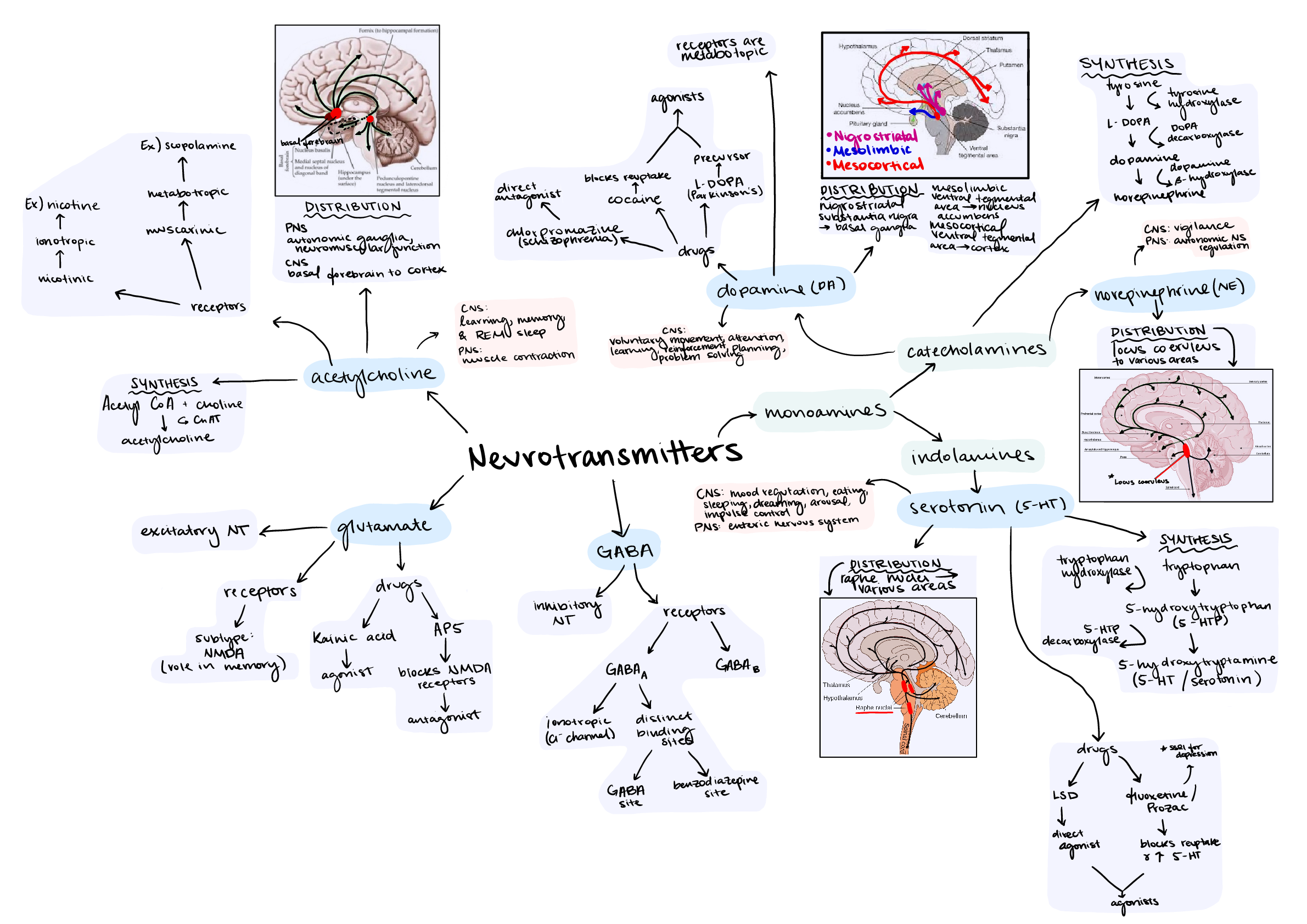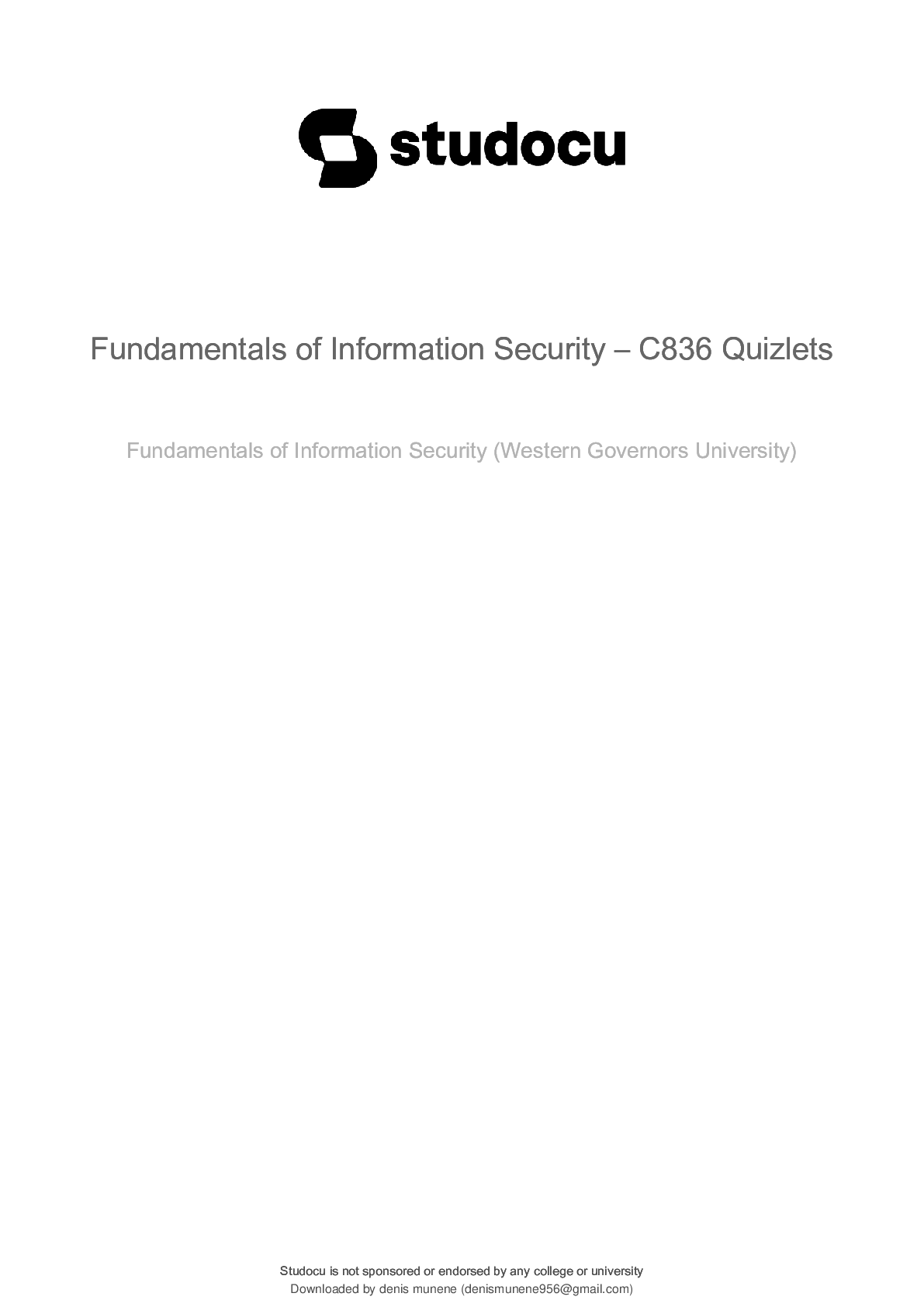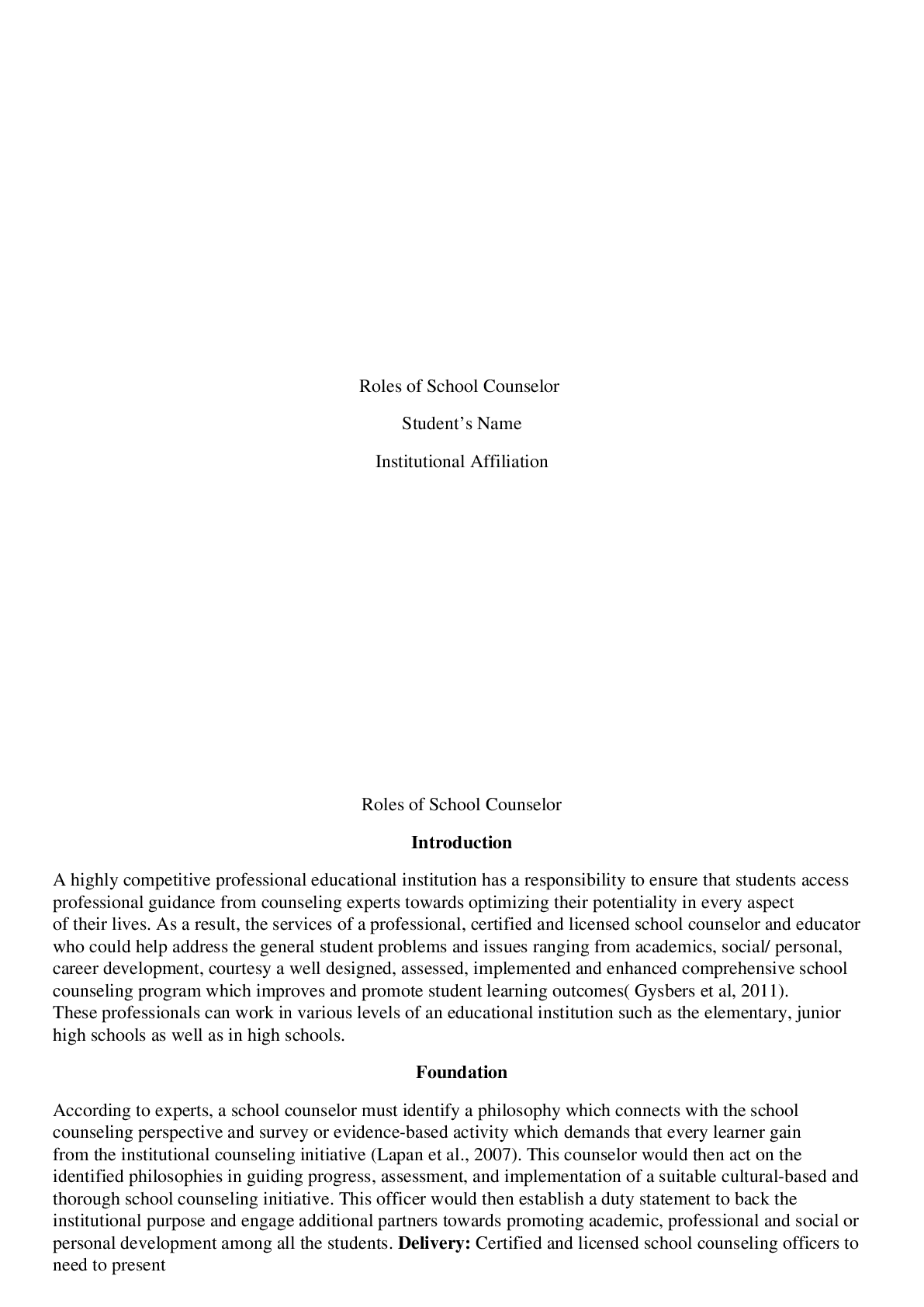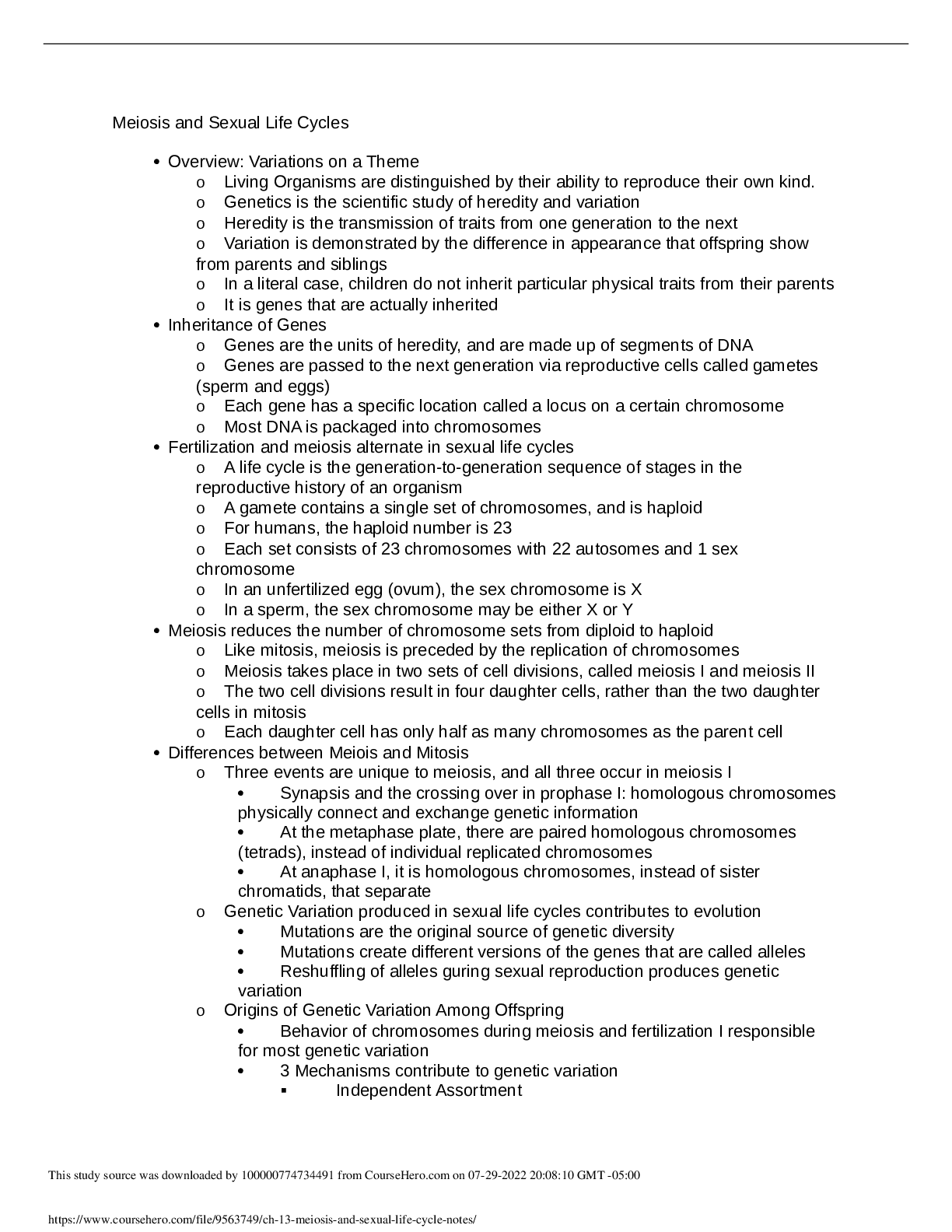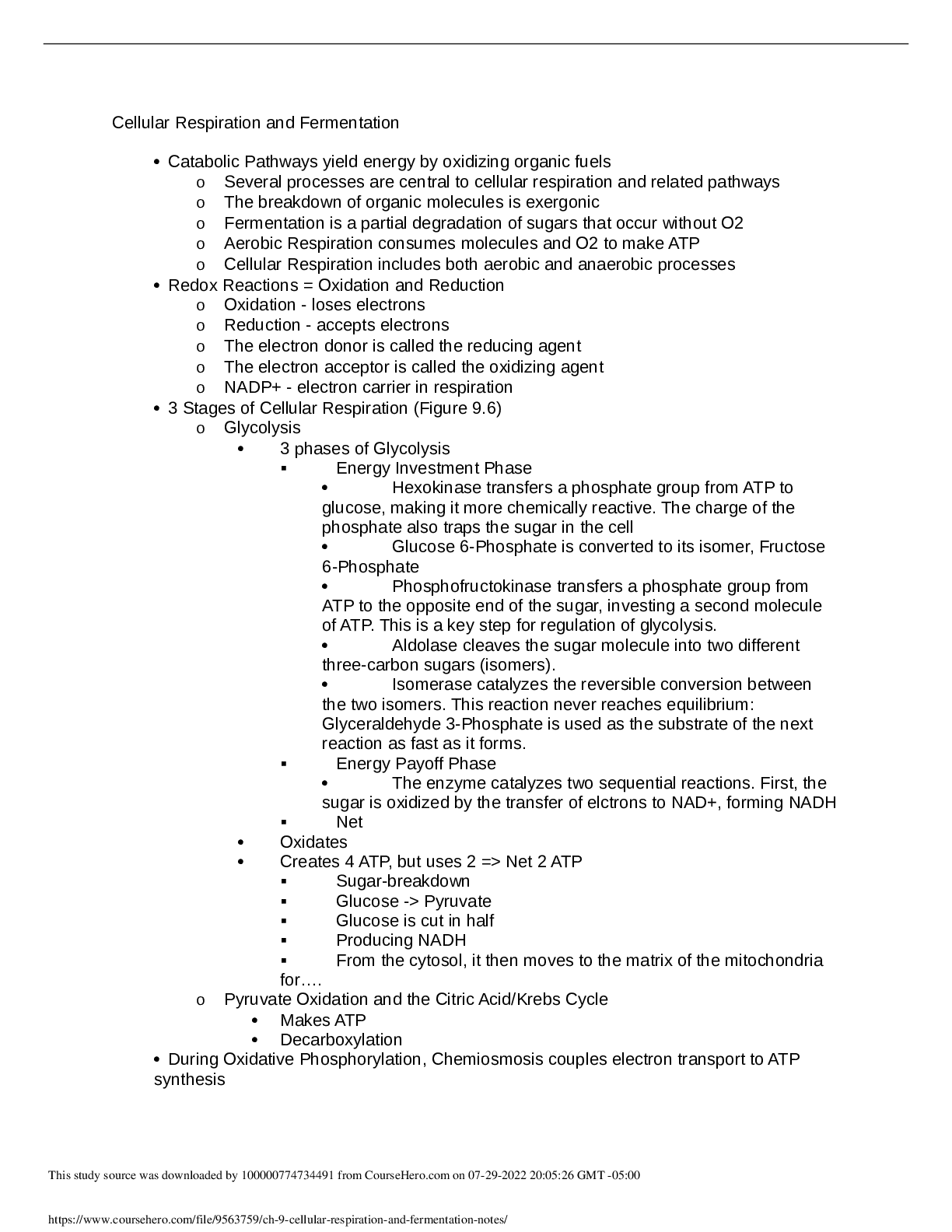*NURSING > Class Notes > BIOL 2510 Human Anatomy Study Notes and Guide (All)
BIOL 2510 Human Anatomy Study Notes and Guide
Document Content and Description Below
1. studies the structure of the body parts and their relationships to one another 2. the function of the body; how the body parts work and carry out thru life-sustaining activities 3. study of ... large body structures visible to the naked eye 4. all the structures (muscles, bones, blood vessels, nerves) in a particular region of the body are body structure is studied system by system 6. study of internal structures as they relate to the overlying skin surface 7. deals with structures too small to be seen with the naked eye 8. the cells of the body 9. study of tissues 10. traces structural changes that occur in the body throughout the life span 11. concerns developmental changes that occur before birth kidney funciton and urine production 13. nervous system 14. operation of the heart and blood vessels 15. groups of similar cells that have a common function 16. the smallest units of living things 17. 5 18. discrete structure composed of at least two tissue types that perform a specific body function 19. extremely complex functions become possible 20. the sum total of all structural levels working to keep us alive 21. includes the activities promoted by the muscular system, such as propelling ourselves from one place to another by running, and manipulating the external environment with our fingers 22. ability to sense changes in the environment and then respond to them 23. breaking down of ingested foodstuffs to simple molecules that can be absorbed into the blood 24. mechanical and chemical breakdown of food 25. includes all chemical reactions that occur within body cells. breaking down substances into their simpler building blocks 26. breaking down of. complex to simple 27. building up of. simple to complex 28. process of removing wastes from the body 29. occurs at the cellular and the organismal level 30. an increase in size of body part or the organism as a whole. increase in the number of cells 31. taken in via the diet, contain the chemical substances used for energy and cell building 32. approx 60-80% of our body weight and single most abundant chemical substance in the body 33. 37c or 98.6f 34. maintain stable internal conditions type of sensor that monitors the external environment and responds to the changes 36. disturbance of homeostasis 37. body is erect with feet slightly apart 38. head, neck, trunk 39. vertical plane that divides the body into right and left parts 41. sagittal plane that lies exactly at the midline 42. lie vertically and divide into anterior and posterior. also called, coronal plane 43. runs horizontally form right to left, dividing the body into superior and inferior parts 44. cuts made diagonally between the horizontal and vertical planes 45. inner layer, circular: middle; longitudinal: outer 46. name based on direction of arrangement 47. protects the nervous system organs. contains the cranial cavity and the vertebral or spinal cavity 48. contains the thoracic cavity and the abdominopelvic cavity. collectively called the viscera 49. surrounded by the ribs and muscles of the chest 50. lungs 51. encloses the heart and remaining thoracic organs 52. stomach, intestines, spleen, liver 53. pelvis and urinary bladder, some reproductive organs and the rectum 54. covers the organs 55. lines the organs 56. defines the extent of the cell wall 57. series of integral protein molecules in the plasma membrane of adjacent cells fuse together 58. anchoring junctions- mechanical couplings scattered like rivets along the side of a budding cells to prevent their separation 59. a communicating junction between adjacent cells 60. allows ions to pass freely from cell to cell 61. allows transmission of depolarizing current across entire heart 62. the tendency of molecules or ions to move from an area where they are in higher concentration to an area of low concentration 63. nonpolar and lipid soluble substances diffuse directly through the lipid bilayer 64. gas exchange occurs by? 65. transported substance either binds to protein carriers or moves through a cannel 66. diffusion of a solvent through a selectively permeable membrane 67. the tendency of water to move into a cell by osmosis 68. back pressure exerted by water agains the membrane 69. the same concentrations inside as well as outside of the cell 70. higher concentration outside than inside 71. higher concentration inside than outside 72. requires carrier proteins that combine with substances 73. transport macromolecules across with vesicles 74. the cell engulfs some relatively large or solid material cell drinking; aka fluid phase endocytosis 76. bind to only certain proteins to enter cell 77. eject substances from a cell into the extracellular fluid 78. play a role in embryonic development and wound repair and in immunity 79. bind specifically to plasma membrane receptors 80. cellular material between the plasma membrane and the nucleus; site of most cellular activities 81. viscous fluid in which the other cytoplasmic elements are suspended 82. metabolic machinery of the cell; carries out a specific function in the cell 83. "powerhouse of the cell"; provide ATP supply 84. sites of protein synthesis 85. interconnected tubes and parallel membrane enclosing fluid filled cavities 86. "traffic director"; modify, concentrate, and package proteins from rough ER to export from the cell 87. contain oxidase and catalyse 88. abundant in phagocytes; eat things in the cell 89. product, degrade, store, and export biological molecules, and degrade potentially harmful substances 90. "cell skeleton" supports the cell structure 91. strengthens cell surface and resists compression 92. determine the overall shape of the cell as well as the distribution of cellular organelles 93. cell center 94. whiplike motile cellular extensions that occur on exposed surfaces 95. what is mucus with filtrates moved by? 96. longer than cilia; only one in human body is sperm 97. centrioles forming the bases of cilia and flagella 98. project from all exposed cell surfaces. increase plasma membrane surface area and mostly on absorptive cells 99. control center of a cell 100. in skeletal muscle cells, bone destruction cells, and liver cells; multiple nucleus 101. double membrane barrier separated by a fluid-filled space 102. 30% dna and 60% histones and 10% rna 103. fundamental units of chromatin 104. period from cell formation to cell division 105. division of the nucleus 106. the division of the cytoplasm 107. segment of a dan molecule that carries instructions for creating one polypeptide chain 108. amino acid specifying informational sequences 109. transfers info fro a dna base to the complementary base of an mRNA molecule 110. the enzyme that oversees the synthesis of mRNA 111. nucleic acid translated into proteins found outside the cell; body fluids, cellular secretions, and extracellular matrix 113. programmed cell death 114. Mechanism of eliminating self cells without triggering an inflammatory response 115. a decrease in size of an organ or body tissue 116. accelerated growth 117. sheet of cells that covers a body surface or lines a body cavity; avascular 118. upper free surface exposed to the body exterior or the cavity of an internal organ 119. attached 120. adjacent to the basal surface; adhesive sheet that consists of glycoproteins 121. deep to the basal lamina; extracellular material containing a fine network of fibers 122. the two lamina single layer of cells. absorption, secretion, and filtration occur 124. composed of two or more cells layers stacked; high abrasion areas such as skin surface or the lining of the mouth 125. flattened and scalelike 126. boxlike, approximately as tall as they are wide 127. tall and column 128. eventually lose their ducts, product hormones 129. one or more cells that make and secrete a product 130. 3 pairs of glands in salivary glands 131. aqueous fluid that usually contains proteins 132. internally secreting 133. secretions placed directly into blood; make up whole system of body; blood transports secretions to target tissues for functions 134. e secretes hormones that are transported to target tissues via blood causes changes in metabolic activities in specific cells exerts effects relatively slowly (seconds or even days) 137. has generally prolonged effects 138. externally secreting 139. sweat, salivary, etc.; secretions transported through ducts; function within a particular system of the body 140. messenger chemicals that are secreted by exocytosis directly into the extracellular space 141. why is diagnosing and treatment difficult? 142. secrete their products onto body surfaces or into body cavities 143. secrete their products by exocytosis as they are produced 144. accumulate their products within until they rupture 145. most abundant and widely distributed of the primary tissues; most of skin 146. unstructured material that fills the space between the cells and contains the fibers provide high tensile strength 148. fibroblasts 149. chondroblasts 150. qualities between dense connective tissue and bone 151. osteoblasts 152. strength and stretchability;found in the ear and epiglottis 153. mature bone cells 154. the most atypical connective tissue 155. skin 156. line all body cavities that open to the outside of the body 157. membranes found in closed ventral body cavities 158. line the thoracic wall and cover the lungs 159. serous membranes covering lungs and lining thoracic cavity 160. pericardium encloses the heart 161. encloses the abdominopelvic viscera 162. 4-chambered muscular organ within the mediastinum, medial cavity of thorax 164. receives 1/20th of blood supply how much of our body weight is the heart? 166. how many times a year does the heart contract? How many gallons of blood/year does the heart eject? 168. 3 layers of the heart 169. lubricative outer covering, protects heart, anchors heart, prevents overfilling of heart 170. muscular contractions that eject blood from heart chambers 171. lubricative inner lining of chambers and valves 172. blood enters right atrium through? 173. blood returns to the body through 174. Flowing from tricuspid valve to? 175. through pulmonary semilunar valve to? to the lungs and back to the left atrium from? 177. from left atrium through bicuspid valve to? 178. through aortic semilunar valve to? 179. produced by closing of the valves 180. caused by valvular leakage or turbulence of blood 181. heart murmursgenerally of no clinical significance; 10% 182. when cusps of valves do not form a tight seal 183. when walls around valve is roughened or constricted 184. frequent in hcildren, caused by turbulent movement of blood through heart during excercise 185. striated, has myosin and actin myofilaments 186.1-2 nuclei/cell, short, thick, branched, and interconnected cells 187. T tubules, I bands, sarcoplasmic reticula 188. contraction by sliding 189. long and thin, multinucleated 190. what is the tongue made of? 191. What is not found in Cardiac Muscle? 192. junction of plasma membranes of adjacent cardiac cells 193. prevent separation of adjacent cardiac cells during contraction 194. desmo2 types of intercalated discs 195. amount of blood pumped by each ventricle in 1 minute 196. heart rate x stroke volume 197. Nicotine stimulates heart to increase? 198. : HR X SV 199. volume of bloodp umped out by a ventricle with each beat 200. typical adult has how many liters of blood? 201. Cardiac Reserve difference between resting and maximal cardiac output 202. heart rate number of beats/min 203. 140-160/ min heart rate is fastest in the fetus at what rate? 204. es heart rate increases/decreases with age? 205. average heart rate in women? 206. Average heart rate for men? 207. most important extrinsic control of heart rate 209. activation of sympathetic nervous system is by? 210. Chemical Regulation hormones 211. active form of norepinephrine 212. increases metabolic rate and heat production in the body 3 ions reduced level of calcium in blood 215. reduces heart rate 216. elevated levels of calcium in blood 217. interferes with contractions 218. two types of calcium diseases 219. sodium related disease.. build up of sodium may block contractions 221. too much potassium too much potassium may lead to cardiac arrest 223. age, gender, exercise, body temp factors that influence regulation of heart rate 224. what type of delivery system does the body have? 225. what do the blood vessels do within the body? 226. 3 types of blood vessels carry blood away from heart 228. arteries Where is blood pressure the greatest? 229. veins carry blood to heart 230. capillaries have contact with cells of body 231. 3 How many layers are in a blood vessel? 232. 1/3 how many will die from breast cancer of the 1/13 233. Tunica interna innermost layer 234. contains endothelium lining the lumen that minimizes friction 235. middle layer of the blood vessel 236.tunica media most circularly arranged smooth muscle cells and elastin 237. outermost layer 238. protects, reinforces, and anchors decreases diameter of lumen 240. vasodilation increases diameter of lumen 241. Vasodilation Cytokines cause the capillary walls to dilate and become leaky; plasma flows to site of injury making it red, swollen and warm. 242. volume of blood flowing through a vessel, organ, or body in a given period 243. created by action of heart, is force exerted by blood against vascular walls, measured in millimeters of mercury, keeps blood moving 244. opposition to flow, amount of friction in vessels 245. most resistance is away from heart in peripheral circulation 246. 3 sources of resistance 247. device used to measure arterial pressure, usually used to check brachial artery 248.normal pressure of an adult 249. produced as blood is ejected from heart during ventricular diastole 250. difference between systolic and diastolic pressure 251. blood pressure of 140/90 or greater 252. places increased strain on heart and vessels, common in obese people 253. ? 254. lifeline of the body 255. study of blood excessive levels of bacteria or toxins in blood; blood poisoning 257. clotted blood in tissues; usually results from injury 258. continued rapid heart rate of >100 beats/min persistent in heart rate of <60 beats/min used to identify abnormal cardiac rhythms causes unrestricted reproductions of immature leukocytes; causes anemia and tendency to bleed 262. genetic disease; erythrocytes are disfigured or destroyed 263. infectious disease transmitted by a virus in saliva; "kissing disease" 264. hardening of arteries 265. clogging of coronary vessels with fatty buildup 266. an expansion or bulging of heart, aorta, or other artery chemical that promotes formation of urine, reduces blood volume, often prescribed to manage hypertension 268. failure of heart to contract 269. heartbeat so strong, fast, or irregular that person becomes aware of it 270. weakened veins that become stretched or swollen and leak 271. varicose veins in rectum 272. inflammation of vein; may result from bacterial infection, trauma, aftermath of surgery 274. incision in vein to withdraw blood 275. low blood pressure, usually not associated with health problems. 276. includes heart attacks; inadequate coronary blood supply, anatomical disorder, or conduction of disturbances 277. an inflammation of heart muscle followed by cardiac enlargement and congestive heart failure 278. Metabolism of every cell requires? 279. refers to breathing. refers to exchange of gases between atmosphere, blood, and individual cells 280. thin-walled structures through which gas is exchanged into cardiovascular system must be ? 281. respiratory system this membrane must be kept moist so oxygen 282. cellular respiration exchange of gas occurs in? 283. urination micturation 284. pooping defacation 285. childbirth parturition 286. nose houses olfactory receptors 287. nasal cavity pseudo stratified ciliated columnar epithelium filters air here and elsewhere in respiratory passageway 288. lysozyme antibacterial enzyme is secreted in this region 289. paranasal sinuses produces mucus, provides sound resonance, expels irritants from nasal cavity 290. larynx voice box, short passageway that connects pharynx to trachea 291. The larynx: produces voice, provides an open airway, and routes air and food into proper channels 292. passageway for air; sound production; prevents food and foreign materials from entering trachea larynx 293. pharynx passageway for air into larynx and for food into esophagus 294. dead macrophages are carried out by ciliary current to? receives bolus from oral cavity 296. automatically continues deglutition of bolus to esophagus 297. pharynx common passageway for digestive and respiratory systems 298. keep food out of lower respiratory passages 299. cough reflex initiated if something other than air enters the larynx 300. flexible tubular connection between larynx and bronchial tree 301. bronchial bronchi and branching bronchioles in lung 302. tubular connection between trachea and alveoli 303. alveoli microscopic, membranous air sacs within lungs 304. functional units of respiration 305. site of gaseous exchange between respiratory and cardiovascular systems 306. alveoli sockets containing teeth 307. lungs located in plueral cavities in thorax 308. area with alveoli; begins with terminal bronchioles within lungs 309. walls of alveoli composed of squamous epithelial cells (type I) 310. formed at junction of alveolar and capillary walls 311. Oxygen to blood, carbon dioxide to? 312. type II cells cuboidal cells in walls of alveoli 313. type II cells secrete surfactant that coats alveolar surfaces 314. alveolar macrophages crawl freely along internal alveolar surface 315. eupnea normal respiratory rate and rhythm (12-15/min) 316. inspiration and expiration 2 phases of breathing 317. inspiration air flows into lungs 318.during inspiration volume of thoracic cavity increases during? 319. inspiratory muscles diaphragm, external intercostals contract 320. moves down and flattens diaphragm during inspiration 321. elevated and broadens rib cage during inspiration 322. pulled forward sternum during inspiration 323. zero during inspiration, air flows into lungs until intrapulmonary pressure is equal to? 324. air flows out of lungs until intrapulmonary pressure is? 325. air flows out of lungs 326. risesduring expiration the diaphragm? 327. descends due to gravity the rib cage during expiration? 328. lowered the sternum is? during expiration 329. 500 mL in both sexes 330. tidal volume amount of air exhaled or inhaled at rest 331. amount of air that can be forcefully inhaled after normal tidal inhalation amount of air that can be forcefully exhaled after normal tidal exhalation 333. amount of air remaining in lungs after forced exhalation 334. total lung capacitymax amount of air in lungs after max inspiratory effect 335. total lung capacity 336. vital capacity TV+IRV+ERV 337. max amount of air that can be inspired after max expiratory effort 338. Inspiratory Capacity max amount of air that can be inspired after normal expiration 339. TV+IRV 340. volume of air in lungs after a normal tidal-volume expiration 341. Functional Residual Capacity ERV+RV non respiratory movements of air 343. cough taking a deep breath, closing glottis, and forcing air from lungs against glottis 344. similar to cough, but air forced through nasal and oral cavaties 345. g inspiration with short expirations 346. emotionally induced mechanism sudden inspirations caused by spasms of muscular diaphragm 348. hiccups sound occurs when inspired air hits vocal chords of closed glottis 349. yawn very deep inspiration with mouth wide open 350. yawn ventilates all alveoli 351. infant respiratory distress syndrome disorder of neonates 352. alveoli of lungs are not developed sufficiently to sustain life until after? responsible for about 1/3 of neonatal deaths result from deficient production of surfactant fluid in alveoli incomplete formation of palate 356. opening between oral and nasal cavities 357. genetic disorder that produces persistent infection 358. an inherited disease of exocrine glands, particularly the pancreas. Pancreatic secretions are too thick to drain easily, causing ducts to become inflamed and promoting connective tissue formation that occludes the drainage passageway 359. causes over-secretion of mucus that clogs respiratory passages 360. inhaling something into lungs 361.when nasal septum is far to one side that it obstructs breathing 362. mushroom-like benign neoplasms of nasal mucosa 363. epistaxis caused by many things including injury, high blood pressure, and leukemia 364. inability ti breathe in horizontal position 365. when air enters pleurae cavity surrounding either lung and causes lung to relax 366. s collapse of lung from any cause 367. caused by rapid travel from low to very high elevation 368. response to long-term change from low to high elevation 370. hyperventilation depth and rate of breathing are increased 371. n enhances alveolar ventilation; flushed carbon dioxide out of blood, increases pH of blood low level of carbon dioxide in blood breathing is slow and shallow 374. apnea cessation of breathing may occur until carbon dioxide again stimulates respiration 375. rhinitisinflammation of nasal mucosa 376. inflammation of sinuses 377. most widely spread of all respiratory diseases 378. viral disease that causes inflammation of upper respiratory track 379. tonsillitis inflammation of tonsils 380. laryngitis inflammation of larynx, produces hoarse voice and limits ability to talk 381. hypoxia inadequate delivery of oxygen to body tissues 382. skin and nail beds become bluish 383. leading cause of death from fire; acute infection and inflammation of lung tissue accompanied by accumulation of fluid 385. pleuristy inflammation of pleurae; surfaces may become dry or rough 386. chronic bronchitis and obstructive emphysema 387. dyspnea difficult or breathing; gets progressively more severe 388. affects people who are allergic to dust mites, cockroaches, and cats dogs fungi, c 389. causes swelling and blocking of lower respiratory tubes 390. inhaled irritants lead to chronic excessive production of mucus 391. bacteria thrive in stagnant pools of mucus, inflammation and fibrosis of mucosa in lower respiratory pathways 392. obstructive emphysema caused by breakdown of alveoli 393. obstructive emphysema leads to permanent "barrel chest" due to trapped air in lungs 394. TB about 1/3 of the human population is infected but most do not develop symptoms 395. silicosis chronic respiraoty disorder caused by tiny dust particles that get into lungs 396. silicosis associated with people in construction and open-pit mines 397. silicosis particles cut little holes in alveoli walls and cause them to fill with blood, preventing adequate amounts of oxygen and causing the heart to beat faster 398. black lung disease coal miners and welders; macrophages are overwhelmed with soot; accumulation of carbon in alveoli 399. lung cancer caused by repeated inhalation of irritating substances such as cigarette smoke 400. lung cancer 1/3 of all deaths from cancer each year 401. the lungs Tracheotomy 402. Epistaxis 403 hat is ? Pneumonia 404. is Orthopnea 405. the child to respiratory infections cystic fibrosis 406. Small cell carcinoma, Adenocarcinoma, Squamous cell carcinoma 407. Emphysema 408. acclimatization 409. NOT HEADACHE, NOT SHORTNESS OF BREATH, NOT NAUSEA 410. Eupnea 411. : hypoxia 412. are hiccups 413.nitrogen 414. Expiratory reserve volume 415. surfactant 416. pneumothorax 417. ciliated, psuedostratified, columnar, epithelial 418. defacation and lifting heavy loads 419. Laryngitis 420. The nasal cavity is moisten the air. paranasal sinuses 421. Pleurae from cells to blood internal respiration (cellular respiration) 423. moisten, cleanse, warm 424.asic functional units of respiration Alveoli 425. is rhinitis 426. is and redness of the skin over the inflammed vessel. phlebitis 427. is a the artery at risk of rupture Aneurysm 428. Heart failure, renal failure, stroke, vascular disease 429. : Pulse pressure : viscosity of blood, length of blood vessels, diameter of blood vessels 431. have become tortuous and dilated bec of incompetent (leaky) valves Varicose veins 432. Externa 433. Asystole 434. is the volume Stroke Volume 435. : heart murmurs and fairly common in young kids 436. The plasma Intercalated discs 437. cells of cardiac muscle are: intercalated (long, thick, branched?) 438. The ____ is on the inner surface of the myocardium, it lines chambers of the heart, and it covers the endocardium 439. is accumulated clotted blood in the tissues, usually resulting from injury hematoma 440. that does not consider other agglutinogens in blood that can trigger reactions to transfusions AB -persons with AB blood type are theoretically universal recipients and can receive blood transfusions from any of the ABO groups 441. Agranulocytes include: lymphocytes, monocytes, and macrophages. 442. Granulocytes are: neutrophils, basophils, and eosinophils 443. Eosinophils counterattack parasitic worms 444. are the only formed elements in blood that are compete cells with nuclei and the usual organelles Leukocytes 445. All types of blood cells are formed in the ____ bone marrow red 446. refers to the percentage of formed elements in a sample of blood (mostly red blood cells) hematocrit 447. is an incision in a vein that is made to draw a sample of blood Phlebotomy 448. Nicotine from tobacco causes _____, _____ BP, and _____ CO causes Vasoconstriction, Raises Blood Pressure, Increases Cardiac Output 449. Pulmonary arteries carry ______ blood oxygen poor 450. is the automatic adjustment of blood flow to each tissue in proportion to the tissue's requirements Autoregulation 451. refers to an increase in diameter of the lumen of the blood vessels vasodilation 452. Although the insidious progress of atherosclerosis begins in childhood, it is accelerated by: smoking and stress 453. Reduced levels of Calcium in the blood is referred to as: hypocalcemia 454. At rest, HR of an average fetus is ____ than that of an average adult female greater than 455. is defined as the contractile strength achieved at a given muscle length contractility 456. The Epicardium metabolic processes Endotherms 458. Eosinophil 459. Unique to the ABO blood groups is the presence in the plasma of preformed Antibodies called: agglutinins 460. What is used clinically to prevent undesirable clotting in PTs at risk for heart attack or stroke Aspirin, Heparin, Warfarin 461. Prothrombin activator catalyzes transformation of the plasma protein _____ to the active enzyme thrombin Prothrombin 462. Erythrocytes normally constitute 45% of total volume of a blood sample, a percentage known as: hematocrit 463. The respiratory system assists in abdominal compression during: Micturition, Parturition, Defacation 464. refers to mushroomlike benign neoplasms of the nasal mucosa nasal polyps 465. Asthma is characterized by episodes of: coughing, dyspnea, wheezing, chest tightness 466. About ____ of the world's population is affected with TB 1/3 467. Symptoms of acute mountain sickness include: headaches, dizziness, nausea, fatigue 468. very high concentration of oxygen generates huge amounts of harmful free radicals resulting in disturbances to brain and spinal cord, coma, and death 469. The total lung capacity is tidal volume plus _____ volume. inspiratory reserve volume, expiratory reserve volume, residual volume 470. During contraction, the muscular diaphragm _____ flattens 471. Inflammation of the pleurae that often results from pneumonia Pleurisy 472. On average, a human clears and swallows more than ____ alveolar macrophages per hour 2,000,000 473. Because smoking inhibits and ultimately destroys cilia, smokers with respiratory congestion should avoid medications that inhibit the ______ reflex cough 474. The valsalva maneuver aids: lifting, defecation, and stabilization 475. Rhinitis may be caused by: cold viruses, streptococcal bacteria, allergies 476. Vibrissae 477. The respiratory system transports: O2, CO2, and Microorganisms 478. water, hormones, proteins 479. Erythrocytes have: hemoglobin 480. is a condition in which the blood has abnormally low oxygen-carrying capacity Anemia poor caused by extreme vasodilation Vascular shock 482. Constant flow of blood to the cerebrum is necessary because neurons are totally intolerant of: Anosmia (cant smell) 483. the auscultatory method, a sphygomomanometer, a BP cuff 484. the kidneys to conserve water. Antidiuretic hormone and Vasopressin 485. the neck and thorax Baroreceptors 486. Endocarditis may be caused by _____ Contaminated needles, an autoimmune response, and fungal infection 487. the volume of blood pumped out by 1 venticle with each beat stroke volume 488. Electrical currents generated in and transmitted through the heart spread throughout the body and an Electrocardiograph 489. _____ forces the heart to repump the same blood over and over because the valve does not close endocardium 491. The apex of the heart is held in place by ______. Frenulum 492. What blood group is the universal donor O 493. _______. Hair follicles, sebaceous glands, sweat glands 494. 495. Otorhinolaryngology is a branch of medicine that deals with diagnosis and treatment of diseases of the _____. ears, nose, and throat 496. 497. Emphysema is distinguished by permanent enlargement of the: bronchial passages 498. ______ is an increase in the rate and depth of breathing that exceeds the body’s need to remove carbon dioxide. O2 Vital 501. Boyle's law 502. Remarkably efficient _______ crawl freely along the internal alveolar surfaces. alveolar macrophages 503. smokers 504. . The ____ maneuver is a procedure in which air in the victim’s lungs in used to pop out or expel an obstructing piece 505. The air passageways in the lungs branch and branch again, about ____ times overall. 23 506. _____ is collapse of a lung from any cause. atelectasis 507. 508. is swallowing food to move it from the mouth to stomach. Deglutition 509. There are _____ salivary glands in the mouth. 6 -3 pairs 510. Kidneys metabolize vitamin _____ into its active form. D 511 Labial frenulum 512. ______ are the structural and functional units of the kidneys. nephrons 513. During swallowing, the soft palate and its pendulous ______ move supriorly, an action that closes off Uvula 514. hemophilia 515. is the amount of blood pumped out by each ventricle in one minute cardiac output 517. HR is significantly influenced by: age, gender, exercise, and body temp 518. veins that have become tortuous and dilated because of incompetent valves 519. Ingestion of alcohol causes BP to drop by: inhibiting release of anti-diuretic hormone, depressing the vasomotor center, and promoting vasodilation 520. On average, the HR of a trained athlete is ______ the HR of a developing fetus 521. The respiratory zone, the actual site of gas exchange is composed of _____ 522. The part of the nasal cavity just superior to the nostrils called the _____ is lined with skin containing sebaceous and sweat glands and numerous hair follicles 523. 524. Areas with rich blood supplies are required for ____ is an antibacterial enzyme secreted in the nasal cavity, that physically traps dust, bacteria, etc. and chemically destroys bacteria Lysozyme 526. Sufonamides (Sufanilamide, sufamethoxazole, trimethoprim) 527. Isoniazid Liver Damage 528. Isoniazid 529. Isoniazid Synthetic Amoxicillin, Piperacillin) Narrow/ broad (depending on the drug) 532. Penicillium notatum and penicilium chrysogenum and some are semisynthetic 533. Cephalosporins (cephalothin, cephalexin) Allergic reactions, kidney damage 534. Cephalosporins (cephalothin, cephalexin) Broad 535. ) Few Reported 537. Carbapenems (Meropenem) Broad Spectrum 538. Carbapenems (Meropenem) Strepromyces cattley 539. Vancomycin Gram- positive bacteria, especially staphylococci 541. Vancomycin Streptomyces orientalis 542. Bacitracin Kidney damage, if injected 543. Polymyxin B , especially in wounds 545. Polymyxin B Bacillus Polymyxa 546. ) Hearing defects and kidney damage 547. , neomycin) Primarily gram negative bacteria and staphylococci 548. Aminoglycosides (streptomycin, gentamicin, neomycin) Streptomyces species, micromonospora species 549. cyclines (chlortetracycline, minocycline, doxycycline) Discoloration of teeth, kidney and liver damage 550. Chloramphenicol Allergic reactions, Gray syndrome 551. Broad Spectrum 552. 553. Macrolides (Erythromycin,Clarithromycin, Azithromycin) Broad spectrum Psudomembranous colitis 555. Streptogramins (Quinupristin, dalfopristin) Muscle aches, rash and headaches 556. Streptogramins (Quinupristin/ dalfopristin) Resistent strains of staphylococcus and enterococcus 557. Streptogramins (Quinupristin/ dalfopristin) Streptomyces species 558. Oxazolidinones (linezolid) Toxic to mitochondria 559. Sythetic 560. Fluoroquinotones (Levoflaxcin) Gastrointestinal distress and allergic reactions 561. Rifampin Liver damage, allergic reactions 562. Rifampin Tubercle bacilli, some gram-negative bacteria. 563. Rifampin Streptomyces, mediterranei, semisynthetic 564. Rifampin Inhibitor of RNA synthesis 566. Tetracyclines (Chorotetracycline, Minocycline, Doxycycline) Broad, rickettsiae, chlamydiae 567. Lincosamides (Clindamycin) Gram-positive bacteria 568. Lincosamides (Clindamycin) Streptomyces lincolnesis 569. Oxazolindinones (Linezolid) Last resort antibiotics, gram positive bacteria Fluoroquinolones (Levoflaxin) Broad spectrum 572. Competitive inhibitors of DNA precursor synthesis Sulfonamides (sulfanilamide,sulfamethoxazole, trimethoprim) 573. Inhibitors of Cell wall synthesis Isoniazid Penicillins (Penicillin G, ampicillin, amoxicillin, pipercillin) Cephalosporins (cephalothin, cephalexin) Carbapenems (meropenem) Vancomycin Bacitracin 574. Inhibitors of cell membrane function Polymyxin B 575. Inhibitor of protein synthesis Aminoglycosides (Streptomycin, gentamicin, neomycin) Tetracyclines (chlortetracycline, minocycline, doxycline) Choramphenicol Macrolides (Erythromycin, clarithromycin, azithromycin) Lincosamides (clindamycin) Streptogramins (quinupristin, dalfopristin) Oxazolidinones (Linezolid) 576. Inhibitors of DNA sythesis Fluroquinolones (Levofloxacin) 577. Sulfonamides (sulfanilamide,sulfamethoxazole, trimethoprim) Synthetic 579. Baciltracin Bacillus subtilis 580. Tetracyclines( Chloretetracycline, minocycline, doxcycline) Streptomyces species and some semisythetic 581. Chlorophenicol Streptomyces venezuelae 582. Microlides (Erythromycin,clrithromycin, azithromysin) Streptomyces erthreus, some semisynthetic) 583. Glycolysis where Cytoplasm Importance of glycolysis Converts energy, pyruvate necessary for krebs cycle, intermediates feed other pathways 588. Transitional Phaste Where Prokaryotic: cytoplasm Eukaryotic: Mitochondira or cytoplasm 589. Transitional Phase conditions Aerobic 590. Transitional Phase requires Pyruvate, NAD, CoA, enzymes 591. Transitional Phase Products CO2, NADH, Acetyl CoA 592. Transitional Phase Fees Krebs Cycle 593. Krebs Cycle Where Prokaryotic: Cytoplasm Eukaryotic: Mitochondria 594. Krebs Cycle Energy, intermediates 595. Krebs cycle conditions Aerobic (similar anaerobic forms) 596. Required for Krebs Cycle Acetyl CoA, Oxaloacetate, enzymes, NAD, CoA, ADP, FAD, water 597. Krebs Cycle Products CoA, NADH, ATP, oxaloacetate, CO2, enzymes, FADH2, Intermediates 598. Electron Transport Chain Prokaryotes: cell membrane Eukaryotes: Mitochondria 599. Electron Transport Chain Condition Depends on genetics or terminal electro acceptor 600. Electron Transport Chain Requires Enzymes, NADH, FADH2 transport compounds, terminal electron acceptor, hydrogen, ADP 601. Electron Transport Chain Products ATP, NAD, FAD, water, hydrogen, transport/ electron carriers 602. Electron Transport Chain purpose Converts a lot of energy 603. Where for photosynthesis Cyanobacteria:Thylakoid Eukaryotes: Thylakoid within chloroplast 604. Required for photosynthesis Water, Light, Electron acceptor, Redox compound, ADP, Photosynthesis, NADP 605. Photosynthesis Products ATP, NADPH, Hydrogen, O2, Electron carriers and acceptors 606. Importance of photosynthesis Produces ATP for energy 607. Digestive System principal function is to prepare food for cellular use and remove indigestible remains 608. ingestion taking of food into digestive system by way of mouth 609. Mastication chewing to pulverize food and mix it with saliva 610. Deglutition swallowing of food to move it from mouth to stomach 611. deglutition swallowing 612. Segmentation mixes food with digestive juices, increases efficiency of absorption 613. Absorption passage of molecules of food through mucous membrane of small intestine 614. cardio vascular and lymphatic system for distribution Where does Absorption occur? 615. Peristalsis rhythmic, wavelike intestinal contractions that move food through digestive tract 616. Peristalsis Responsible for propulsive movement of chyme, wavelike contractions that usually are weak and short 617. peristalsis both of the 2 muscle layers of small intestine are involved in ? 618. Defecation discharge of indigestible wastes 619. Alimentary canal and Accessory organs Digestive System divided into two parts: 620. Alimentary Canal Organs of GI tract; extends from mouth to anus; gastrointestinal/ GI tract 621. Accessory Organs Aid in breakdown of food 622. teeth, tongue, salivary glands, liver, gallbladder, pancreas Accessory Digestive Organs 623. Gut generally refers to developing stomach and intestines in embryo 624. Viscera any of the organs (lungs, stomach, spleen, etc,) 625. Basic Functional Concepts Action such as sensors, response, and controls are initiated by mechanical and chemical stimuli 626. sensors in GI tract walls detect stretch, osmolarity and pH, substrates and end products 627. Response of GI tract: activate or inhibit glands that secrete digestive juices or hormones stimulate smooth muscle to mix and move contents. 630. structural layers of alimentary canal vary in thickness and function with location 631. Mucosa innermost layer surrounding lumen of GI tract 632. absorbs end products of digestion in blood, secretes mucus, digestive enzymes, and hormones 633. has two layers of smooth muscle 634. continuous with lining of renal tubules and urinary bladder; secretes mucous to lubricate and protect ureter innermost- stretches; have flaps over ureters to prevent backflow 636. Goblet Cells secrete mucus throughout GI tract 637. digestive enzymes Mucus protects GI tract from digestive enzymes Enzymes and hormones secreted in? 639. lamina propria Mucous consists of simple columnar epithelial tissue supported by? 640. propria a thin, binding layer of connective tissue contains numerous lymph nodules important in protecting against disease 642. distention gives increased capacity 643. absoprtion nutrients and water 644. a provides autonomic nerve supply to muscularis mucosae 646. Muscularis externa responsible for segmental contractions and peristaltic movement 647. serosa outermost layer of GI tract 648. serosa binding and protective layer, covered with simple squamous epithelium and connective tissue 649. serosa outermost; only on superior surface, actually a continuation of peritoneum 650. mouth receptacle for food, initiates digestion through mastication, swallowing of food, forms words in speech, air passageway 651. Buccal Cavity Vestibule of the oral cavity; the space between the lips, gums, and the teeth. (vs oral & nasal cavities) 652. Bolus wad of food that we swallow depression between cheeks and lips externally 654. labia minora that includes vaginal and urethral openings 655. oral orifice opening of oral cavity 656. fauces opening between oral cavity and pharynx cheeks and lips assist in manipulating food in oral cavity; aid in speech fold of mucosa that attaches the inner lip to the gum. 659. vermillion or red margin transition zone between outer skin and mucous membrane of oral cavity 660. tongue fills most of oral cavity when mouth is closed 661. tongue responsible for forming bolus 662. 2/3 in oral cavity; 1/3 in pharynx Where does the tongue reside 663. lingual tonsils located on dorsal surface of base tongue 664. taste buds sense taste 665. connects under surface of tongue to floor of mouth 666. small elevations on dorsal surface of tongue 667. tongue 668. to touch, most numerous of the three, aids in licking semisolid food like ice cream keratin and gives tongue whitish appearance 670. fungiform in V-shape on posterior surface, house taste buds 672. underlain by bone 674. palatal rugae transverse ridges along hard palate area 675. soft palate fold of mostly skeletal muscle 676. free edge that projects downward uvula 677. accessory digestive gland, produce saliva produced by 3 pairs of glands 679. parotid gland largest and is below and in front of ear, mumps virus causes swelling ofthis gland 680. inferior to mandible about midway on inside of jaw 681. on the floor of mouth and under tongue 682. teeth we have heterodont dentition 683. 4 pairs, chisel-shaped for cutting and shearing, have single root 684. canines (cuspids) two pairs, cone-shaped for holding and tearing, have single root 685. ) one, two, three roots, used for crushing and grinding 686. two sets of teeth in lifetime 687. 20 deciduous or milk teeth 6months -2.5 years replacement begins age 6-17 689. Dental Formula types, numbers, and position of teeth 690. Deciduous teeth 20 teeth 691. Permanent Formula 32 teeth 692. enamel, dentin, and cementum are calcified and resemble bone, but they are avascular 693. Esophagus located within mediastinum of thorax, originates at larynx and located posterior to trachea, opening through diaphragm for esophagus 696. restricts backflow of food 697. regurgitation of small amounts of gastric contents in esophagus Why cants rats regurgitate 699. Stomach recieves bolus from esophagus 700. stomach most distensible portion of GI tract 701. gastric juice Stomach churns bolus with? 702. stoamch initiates digestion of protein 703. chyme pasty food material that is moved into small intestine 704. duodenum Stomach moves chyme into? relatively fixed, C-shaped tube 706. Regions of the stomach upper, narrow region 708. Fundus dome-shaped part that contacts diaphragm 709. Body large central portion 710. Pylorus funnel-shaped terminal portion 711. Pyloric Sphincter junction with small intestine (prevents backflow) 712. broadly rounded surfaces of stomach 713. medial concave border 714. extends between lesser curvature and liver 715. 716. Greater omentum attached to greater curvature 717. smooth muscle Muscularis layer has 3 layers of? 718. gastric rugae longitudinal folds of mucosa 719. gastric rugae smooth out as stomach fills, many gastric glands 720. Regulation of gastric secretion occurs before food enters stomach; triggered by aroma, taste, sight, or though of food 722. gastric reflex occurs when food reaches stomach; distension of stomach activates stretch receptors; about 2/3 of gastric juice is released by this reflex; 723. gastrin hormone released in stomach; triggered by partially digested proteins and caffeine in stomach 724. gastrin triggered by partially digested proteins and caffeine in stomach 725. occurs when food reaches small intestine 726. hormone released in small intestine reflex inhibits gastric secretions 728. effect is to protect small intestine from hard due to excessive acidity, and to keep small intestine's processing ability in time with chime that is entering the small intestine 729. reflex center to empty stomach through esophagus, pharynx, and oral cavity 730. medulla oblongata vomiting center is controlled by? 731. emetics drugs that can stimulate vomiting reflex 732. pyloric sphinctor strong, sustained contractions of upper small intestine, followed by contractions of? 733. caused by stimuli of vomiting center 734. receives chyme from stomach and secretions from liver and pancreas 735. chemically and mechanically breaks down chyme 736. between pyloric sphincter of stomach and ileocecal valve opening into large intestine 738. Mesentary supports and attaches small intestine 739. contains blood vessel,s nerves, and lymphatic vessels Mesentary 740. muscular wall is relaxed How big is the small intestine 741. Name the 3 parts of the small intestine 742. Jejunum 1 meter long 743. Ileum the remaining 2 meters deep folds in mucosa and submucosa, covered by small villi 745. villus in the Plicae circulares contains a capillary network, autonomically innervated smooth muscle, and a specialized lymph vessel called the lacteal 746. " appearance 747. Rhythmic segmentations,Pendular movements, Peristalsis Mechanical activités of small intestine 748. local, ringlike contractions, occur 12-16/min in regions containing chyme 749. occur primarily in longitudinal muscle layer of SI; no particular frequency; contrictive wave that moves along segment on intestine, stops, then moves in opposite direction 750. how long does it take chyme to travel the length of the small intestines 751. largest internal organ of body 752. Why is the right kidney lower than the left? 753. what gives liver its reddish color 754. saclike organ attached to inferior surface of liver 755. yellowish-green fluid used in digestive process 756. soft, lobulated, glandular organ, secretes pancreatic juice into duodenum 757. both and endocrine and exocrine gland 758. secrete glucagon and insulin which control fate of digested carbohydrates 759. endocrine portion of pancreas insulin 2 hormones secreted by pancreas receive undigested wastes from small intestine 763. absorbs water and electrolytes, forms, stores, and expels feces through defecation reflex 764. how long does it take for food to travel the length of the GI tract? 765. begins at terminal end ___ and terminates at? 766. cecum dilated pouch below ileocecal valve 767. ileocecal valve valve that prevents back flow of chyme 768. vermiform appendix attached to inferior margin of cecum; may serve to resist infection 769. rectum terminal 20 cm; last portion is anal canal 770. external opening of anal canal 771. Some problems in digestive system reflect emotional state? 772. What percent of people over the age of 50 suffer from some type of digestive disorder 773. Why is cleft palate and immediate problem? 774. inflammation of lips 775. ia difficulty swallowing, may be due to obstruction or injury to esophagus inflammation of intestinal mucosa 777. most common type of dysentery caused by ingesting pathogenic bacteria or their toxins 779. an organism that causes food poisoning 780. Botulism most serious type of food poisoning 781. Clostridium botulinum when Botulism, food is contaminated by? 782. Entamoeba histolytica Dysentary is caused by? What is so harmful in the Clostridium botulinum organism that causes Botulism tooth decay 785. persons over age 35 are more susceptible 786. orthodontics branch of dentistry that prevents and corrects misaligned teeth 787. Bruxism grinding or clenching of teeth 788. gingivitis inflammation of gums 789. Halitosis offensive breath odor 790. Mumps viral disease of parotid salivary glans 791. Pernicious anemia caused by lack of vitamin B-12 which is needed to produce mature RBC's 792. injection of vitamin B-12 How to cure Pernicious anemia 793. massive overeating followed by purging, such as self-induced vomiting, taking laxatives, excessive excercising 794. inflammation of liver; may lead to cancer and death; usually caused by virus 795. Many causes of Cirrhosis 797. Hepatomas malignant cancerous tumors of liver 798. Cholelithiasis formation of gallstones; they obstruct common bile duct, cause intense pain 799. jaundice What can Cholelithiasis cause; dysfunction of liver or gallbladder expressed as a yellowish discoloration of skin 800. Pancreatitis inflammation of pancreas; usually caused by blockage of pancreatic duct; 801. trypsin Pancreatitis causes build-up of enzyme? 802. Peptic Ulcer erosions in mucous membrane of stomach or duodenum 803. pepsin Peptic Ulcers are produced by enyme? 804. gastric ulcers ulcers in stomach 805. duodenal ulcers ulcers in duodenum 806. Enteritis inflammation of intestinal mucosa referred to as intestinal flu 807. acute inflammation of appendix 808. surgical removal of appendix 809. inflammation of walls of colon primary cause is lack of fiber foods in diet 811. Colitis inflammation of colon and rectum formation of an abdominal exit of GI tract by bringing a loop of the colon to surface of abdomen. If rectum is removed because of cancer, the colostomy provides a permanent outlet for feces 813. Jujunoileal Bypass A surgical procedure for creating a bypass of a considerable portion of small intestine. It reduces absorptive ability to control obesity discharge of pus at base of teeth at gum line 815. trench mouth contagious bacterial infection that causes inflammation, ulceration, and painful swelling go floor of mouth. Generally it is contracted through direct contact by kissing an infected person . 816. vagotomy surgical transection of the fibers of the vagus nerve where it enter stomach to eliminate nerve impulses that stimulate gastric acid secretion. This procedure helps to cure ulcers 817. 200 Liters per day Kidneys filter 818. toxins, metabolic wastes, excess ions carried away in urine 819. water, salts, pH of blood urinary system regulates these levels in body during prolonged fasting; kidneys supply glucose 821. granular cells from kidney in the urinary system produce? 822. enzyme to help regulate blood pressure and function of kidneys What is the function of renin? 823. produces erythropoietin Kidney 824. erythropoietin a hormone that is produced in the kidneys, stimulates production of RBC's in marrow 825. Vitamin D What does the kidneys metabolize? 826. Parts of urinary system 2 kidneys, 2 ureters, 1 urinary bladder, and 1 urethra 827. urogenital ridge urinary and reproductive systems both originate from? 828. urine and semen transport In male the urethra is used for?` 829. pronephos, mesonephros, metanephros 3 successive types of kidneys in human embryo 830. pronephos develops during 4th week of development 831. Pronephos • Develops through 4th week • most superior, least function o develops other kidneys 832. to cloaca by? 833. Mesonephros develops at end of 4th week; functions throughout embryonic development 834. Metanephros begins development during week 5; becomes functional at end of 8th week; urine is expelled into amniotic fluid 835. Urachus intitally drains urine. later is reduced to a support for urinary bladder 836. ontogeny recapitulates phylogeny 3 types of kidneys illustrate? 837. "lower" invertebrates Pronephric kidneys 838. adult fishes and amphibians Mesonephric kidneys 839. reptiles, birds, and mammals metanephric kidneys 840. kidneys reddish brown and lima-bean shaped renal capsule 842. neal behind peritoneal cavity 843. renal sinus deep depression on concave side 844. hilus entrance to renal sinus 845. renal capsule attachment and protects from trauma and infection 846. Outer Kidneys renal fascia 847. renal fascia anchors kidneys to peritoneum and abdominal wall 848. adipose capsule 849. protection 850. cortex and medulla parts of kidney cortex and medulla 2 major divisions of adrenal gland 852. cortex reddish brown and granular 853. Medulla darker colored and striped; inner layer 854. receives urine from nephrons 855. small collecting depression 856. Major calyx larger collecting depression largest collecting depression 858. Ureter transports urine from kidney 859. Ureters retroperitonealin location; thickest where enters bladder; Mucosa nd Muscularis 860. Nephron functional unit of kidney 861. Nephron responsible for formation of urine, greater than 1,000,000/kidney, rich blood supply 862. allow passage of much water and dissolved solutes 863. urinary tubules o parts of a nephron glomerular (bowman's) capsule proximal convoluted tubule (many microvilli) descending limb of loop of Henle ascending limb of loop of Henledistal convoluted tubule (few microvilli 864. Muscularis inner longitudinal and outer circular layer of smooth muscle 865. muscularis 3 layers and referred to as detrusor muscle 866. Muscular peristaltic waves What moves urine along the length of the ureter 867. Urinary bladder storage sac for urine 868. uterus and vagina Urinary bladder in females contact 869. prostate gland is below bladder urinary bladder in males 870. Apex is secured by the urachus layers of the urinary bladder 872. conveys urine from urinary bladder to outside of body 873. 2 muscular sphincters of the urethra 874. Internal urethra sphinctor formed by detrusor muscle of urinary bladder 875. External urethral sohinctor voluntary striated muscle; 876. urethral orifice in females EUS empties urine through? 877. urethral orifice not as simple as females, prostatic urethra receives drainage from prostate gland and 2 ejaculatory gland 880. membranous erethra and penile urethra 2 ejaculatory ducts in males external urethral muscle is here 882. penile urethra surrounded by erectile tissue 883. Micturition urination 884. micturation reflex action that expels urine from urinary bladder 885. 700-800mL capacity of adult bladder 886. 200-300mL micturation reflex is triggered at? 887. Urology medical specialty in urinary system 888. urinalysis analysis of urine for diagnosing health 889. common malformations of kidneys horseshoe 1/600 unilateral 1/200 890. horseshoes (1/600 births) kidneys are joined together to form a horseshoe shape 891. Unilateral (1/200) kidneys either right next to each other or stacked one on top of the other on one side of the abdomen 892. hypospadias in males only; urethra is open on underside of penis 893. hyperspadias urethra is open on the upper side of penis 894. cystitis a nonsexually transmitted infection of the urinary bladder 895. Pyelitis renal pelvis infection 896. Nephritis nephron infection 897. Pyelonephritis inflammation of entire kidney; may be successfully treated with antibiotic thrapy 898. anuria low urinary output; nephrons may cease to function; blood pressure may be low too 899. nocturia is a condition in which you wake up during the night because you have to urinate. 900. urinary retention bladder unable to expel its urine, treatment may require insertion of catheter 901. nephrotoxin substance that is toxic to kidney 902. renal calculi kidney stones 903. calcium, magnesium, or uric acid kidney stones are made up of? 904. Incontinence Inability to control bladder or bowel movement 905. nocturnal enuresis bed wetting; 906. cystoscopy viewing tube inserted into bladder; examines mucosal surface of bladder 907. trigone regions of points used to describe location of urinary bladder lesions 908. pica appetite for abnormal substances 909. indicates electrolyte deficiencies pica indicates? 910. antacid counteracts acidity; sodium bicarbonate, used to manage heartburn 911. Toll- like receptors Allow sentinel cells to detect extracellular molecules that signify the presence of microbes 912. NOD- like receptors Allow cells to detect internal invaders or cell damage 913. Rig like receptors Allow cells to detect viral nucleic acid. Virally infected cells respond by making interferons and causing nearby cells to prepare to undergo apoptosis if they become infected with a virus 914. Major outcomes of complement system Opsonization, inflammatory response and lysis of cells 915. opsoniaztion Enhanced phagocytosis caused by coating of a particle with an opsonin. 916. Opsonin Molecule such as complement system component C3B and certain antibody classes that binds to invading particles, making it easier for phagocytes to engulf them. 917. Steps of phagocytosis Chemotaxis, recognition and attachment, engulfment, phagosome maturation and phagolysosome formation, destruction and digestion and exocytosis 918. Activated macrophage Increase killing power by assistance from certain T cells 919. Giant Cells Phagocytes fused togetherj 920. Granulomas Macrophages, giant cells and T cells 921. Acute inflammation Characterized by presence of neutraphils 922. Chronic Inflammation Characterized by macrophage and giant cell accumulation and granuloma formation 923. Pyroptosis Eliminating self cells and triggering inflammatory response 924. Types of granulocytes Neutrophils, Eosinophils and Basophils 925. Neutrophils Most common type of circulating leukocyte, few in tissues except during inflammation. Phagocytize and digest engulfed materials. 926. Eosinophils Few in tissues except in certain types of inflammation and allergies. Participate in inflammatory reaction and immunity to some parasites. 927. Basophils In circulation but in most tissues, present as mast cells. Release histamine and other inflammation inducing chemicals from the granules. 928. Mononuclear phagocytes Monocytes, macrophages and dendritic cells 929. Monocytes Differentiate into either macrophages or dendritic cells when they migrate into tissues. Phagocytize and digest engulfed materials 930. Macrophages Present in virtually all tissues; known by various names based on the tissue in which they are found. Phagocytize and digest engulfed materials. 931. Dendritic cells Initially in tissues, but they migrate to secondary lymphoid organs. Collect antigen from the tissues and then bring it to lymphocytes that gather in the secondary lymphoid organs. 932. Lymphocytes There are many different types. Present in lymphoid organs and also in circulation. Participate in adaptive immune responses. 933. Steps of inflammation Trauma Vasodilation Phagocyte attraction Tissue Repair 934. First step of inflammation Tissue macrophages initiate phagocytosis and secrete cytokines 935. Phagocyte attraction Phagocytes (neutrophils and monocytes) attach to blood vessel walls and then migrate into the surrounding tissue (diapedesis) where they arrive and begin phagocytosis. Monocytes differentiate into macrophages and mast cells also arrive. 936. Mast cell Contains many granules rich in histamine or heparin 937. Tissue Repair As bacteria are eliminated a fibrin wall accumulates around the mixture of plasma, leukocytes, bacteria and tissue cells forming a clot. Pus might also be a product. 938. Alternative pathway triggered by C3B binding to microbial invaders 939. Lecithin pathway Triggered by mannose binding lecithin binding to invaders 940. Classical pathway Triggered by antibodies binding to invaders 941. Three pathways of the complement system Classical, alternative and lecithin. 942. All pathways of complement system lead to Formation of C3 convertase which splits C3. 943. When C3 is split, C3A C3A and C5a induce changes that contribute to local vascular permeability and attract phagocytes (INFLAMMATION) 944. C3B binds to microbial cells functioning as an opsonin Also combines with C3 convertase to form an enzyme that splits C5 945. C5 C5A leads to inflammatory responses C5b combines with C6, C7, C8 and C9 to form membrane attack complexes that insert into cell membranes 946. Thyroid gland removed rat and Pituitary gland removed rat with low metabolism. Inject them with what Thyroxine 947. What are the tropic hormones TSH, FSH, ACTH, TRH, CRH 948. what stimulates the thyroid gland to secrete T4 TSH 949. what stimulates the ovarian follicle growth to secrete estrogen FSH 950. what stimulates the adrenal cortex to secrete cortisol ACTH 951. what stimulates the pituitary gland to secrete TSH TRH 952. what stimulates the pituitary gland to secrete ATCH CRH 953. specific cells that hormones exert on target cells 954. what gland regulates metabolism thyroid 955. what gland secretes Aldosterone adrenal gland 956. what gland is associated with increasing reabsorption of calcium parathyroid gland 957. what gland regulates T cell development thymus gland 958. Amylase Starch, pH 7, temp 37 yes will digest 959. Starch solution litmus cream bile salts, pH 7, temp 37 no enzyme to digest 960. lipase litmus cream bile salts, pH 7, temp 37 yes will digest 961. ADH is produced in the hypothalamus 962. The secretion of aldosterone is directly stimulated by _______. Angiotensin II 963. The secretion of ADH is directly stimulated by _______. a change in body fluid osmolarity 964. decrease it 965. of aldosterone, _______. K+ concentration increased and urine volume decreased 966. with _______. both ADH and aldosterone 967. ( True 968. 2 969. wrong enzyme. should not be pepsin. Should be amylase 970. calcitonin 971. Pituitary gland hydrostatic pressure gradients, osmotic pressure gradients and Starling forces 973. tubular reabsorption, tubular secretion, glomerular filtration 974. Estrogen 975. increasing the efferent arteriole radius and decreasing the afferent arteriole radius , what changes can occur to maintain glomerular filtration rate? constriction of the afferent arteriole and dilation of the efferent arteriole 978. _______. the back pressure in the Bowman's capsule Increases pituitary gland 980. renal corpuscle and renal tubule 982. Which of the following resulted in an increase in glomerular filtration rate? decreasing the efferent arteriole diameter and increasing the afferent arteriole diameter 983. increasing the efferent arteriole diameter and decreasing the afferent arteriole diameter 984. by facilitated diffusion into the peritubular capillaries by secondary active transport through transmembrane proteins 985. Glucose reabsorption occurs where in the PCT 986. As of glucose in the _______. distal tubule decreased and bladder decreased 987. glucose is excreted in the urine & not all of the glucose is reabsorbed 988. What of a carbohydrate? placing the tubes in ice 989. peristalsis 990. What secretion peristalsis 991. What type of motility is associated with the digestive function below? Empty the stomach peristalsis 993. What type of motility is associated with the digestive function below?Mechanical Breakdown of food or mix food with saliva 994. What type of motility is associated with the digestive function below? 995. What type of motility is associated with the digestive function below? 996. What type of motility is associated with the digestive function below? Sweep undigested contents of the stomach and small intestine into the terminal ileum 997. What type of motility is associated with the digestive function below? Mix Chyme with intestinal secretions or Bring chyme repeatedly into contact with absorptive epithelium As food travels through the digestive track, the absorption of water and salt back into the body happens in the _______________. 999. As food travels through the digestive track, the absorption of nutrients from the digested food into the 1000. low cortisol and high ATCH [Show More]
Last updated: 1 year ago
Preview 1 out of 72 pages

Reviews( 0 )
Document information
Connected school, study & course
About the document
Uploaded On
Apr 26, 2020
Number of pages
72
Written in
Additional information
This document has been written for:
Uploaded
Apr 26, 2020
Downloads
0
Views
41

